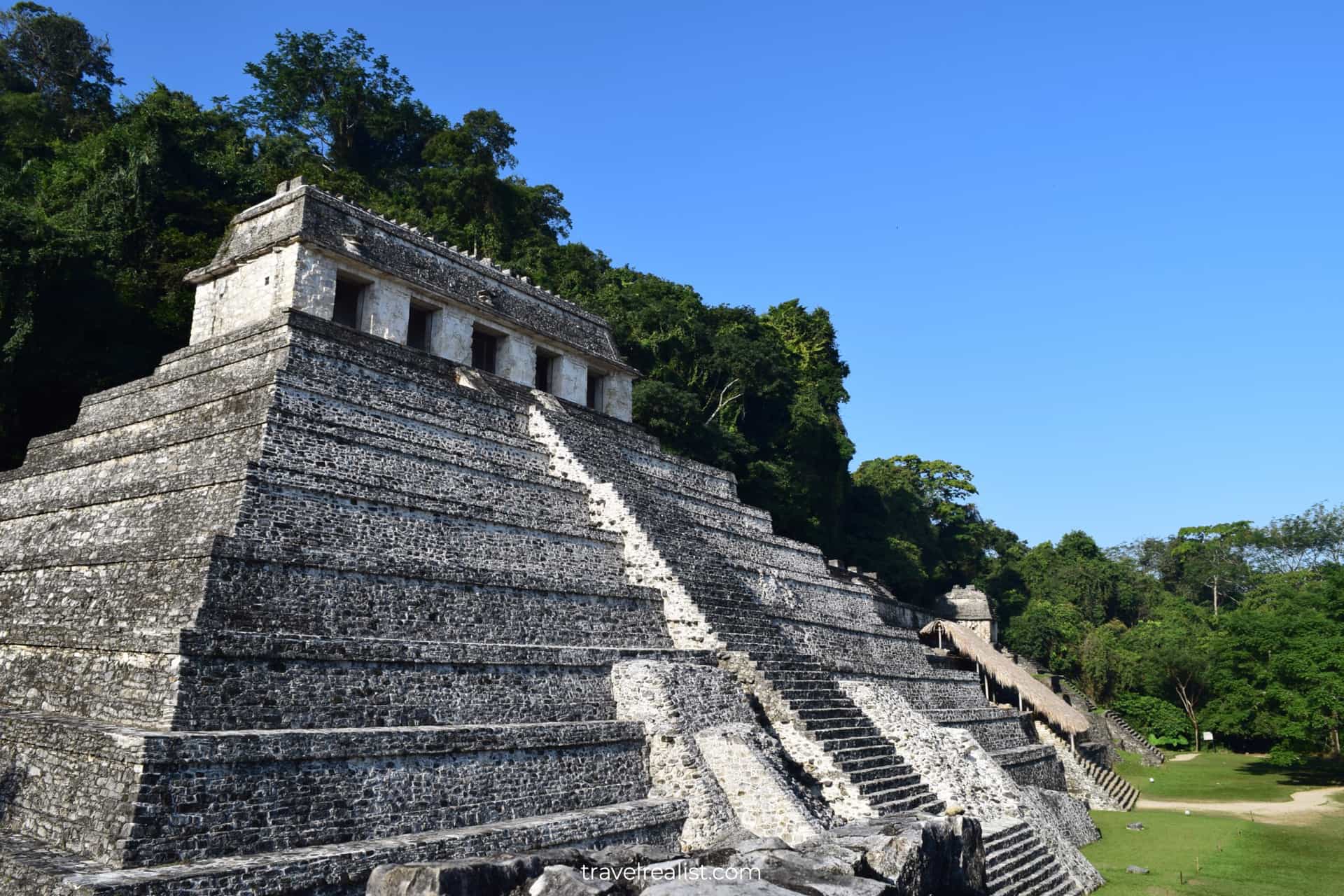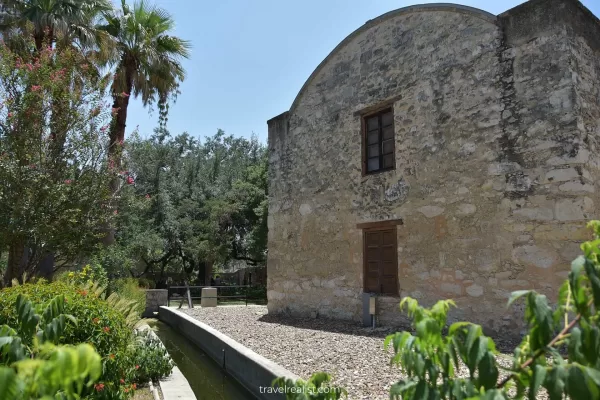Ottawa: 18 Stops on A Self Guided Walking Tour of The Capital
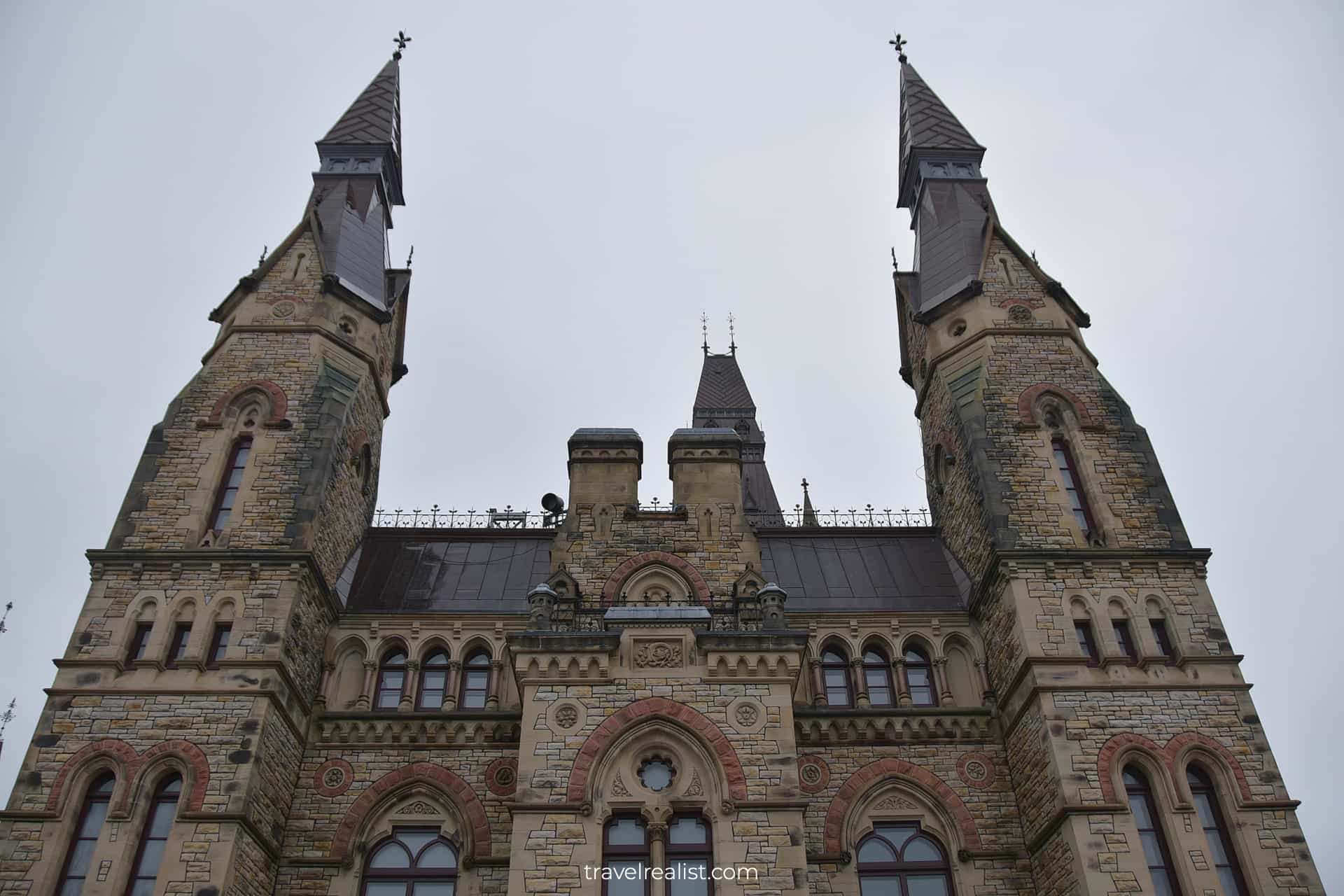
This realistic Ottawa Self Guided Walking Tour Guide helps you plan your next adventure in the capital of Canada.
Ottawa is home to the Government of Canada. There is hardly a better way to explore this city than on a walk. You could see all the main sights of the capital at your own pace.
- Sights & Places of Interest
- 1. Parliament Hill
- 2. Parliament of Canada
- 3. East Block
- 4. House of Commons
- 5. Confederation Building
- 6. Justice Building
- 7. Supreme Court of Canada
- 8. St. Andrew’s Church
- 9. Bank of Canada
- 10. Indigenous Peoples Building
- 11. Office of the Prime Minister
- 12. Rideau Canal
- 13. Fairmont Château Laurier
- 14. Senate of Canada
- 15. Connaught Building
- 16. Notre-Dame Cathedral Basilica
- 17. National Gallery of Canada
- 18. Laurier House
- Getting to Ottawa, Canada
- Where to Stay in Ottawa
- Entrance Requirements & Passes
- Takeaways: Ottawa Self Guided Walking Tour
This post includes affiliate links that will earn us commission if you make a purchase via these links.
Sights & Places of Interest
Some 3 million people visit Ottawa and its sights each year. Most of them explore Parliament Hill and its surrounding areas.
You might wonder why so many people would want to visit the government offices. There is an easy answer. These buildings date back to the 19th and early 20th century.
They are some of the finest examples of different architectural styles. You could see Gothic Revival, Art Deco, Neoclassical, Beaux-Arts, Second Empire, Châteauesque, Tudor-Gothic, and modern architecture.
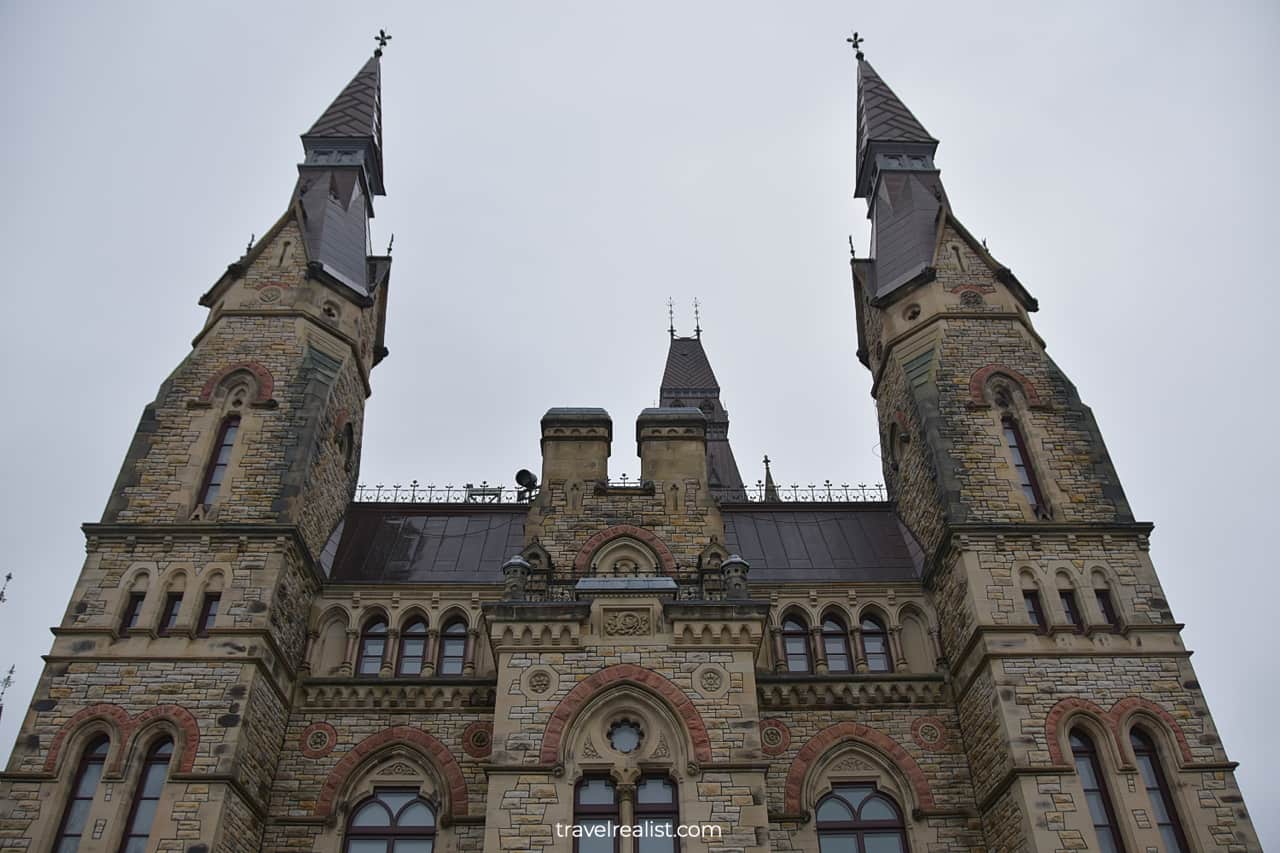
You should make a stop at the Confederation Table Map during your walk. This metal map displays the sights of Parliament Hill, ByWard Market, and District de Hull in Gatineau.
Toledo, Spain has a similar approach to street navigation. But Ottawa does a much better job. You could see the shapes of the main buildings. This way, you could quickly decide where to go and what to see.
This Ottawa Self Guided Walking Tour Guide covers a 2.2-mi (3.6-km) route with 17 stops. It includes an optional stop at Laurier House. This addition would nearly double the distance of the walking tour.
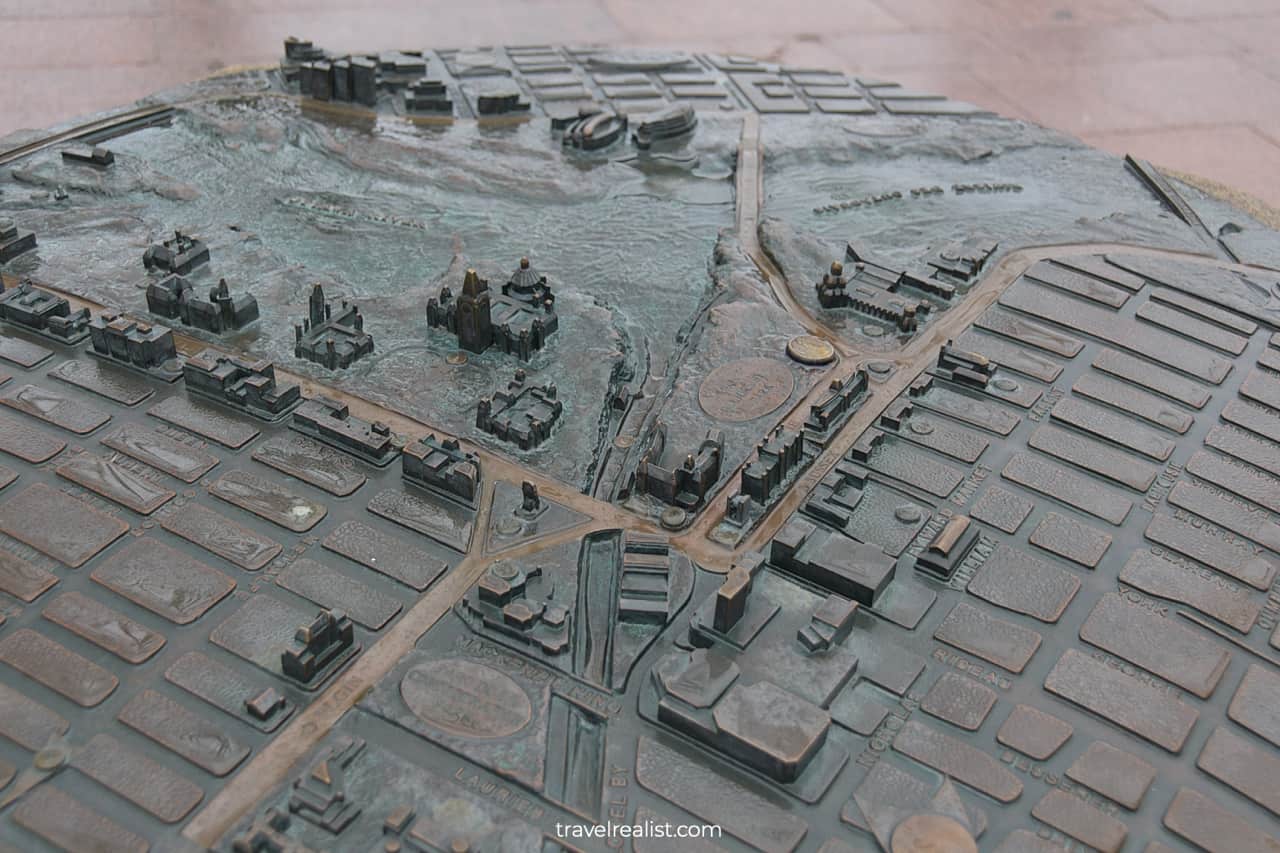
1. Parliament Hill
Every self guided walking tour of Ottawa should start in the heart of the city. There is no better place to explore the capital than Parliament Hill.
Its name is very descriptive. First and foremost, it is a hill on the banks of the Ottawa River and the Rideau Canal. It houses the main government offices of Canada.
The Hill consists of the Center Block, East Block, West Block, Office of the Prime Minister, and Supreme Court. There are also a handful of other, lesser known, government buildings.
You could visit some of them on a guided tour. But most of the Parliament Hill buildings are closed to the public. Still, the Gothic Revival style of this buildings is a sight to see even from the outside.
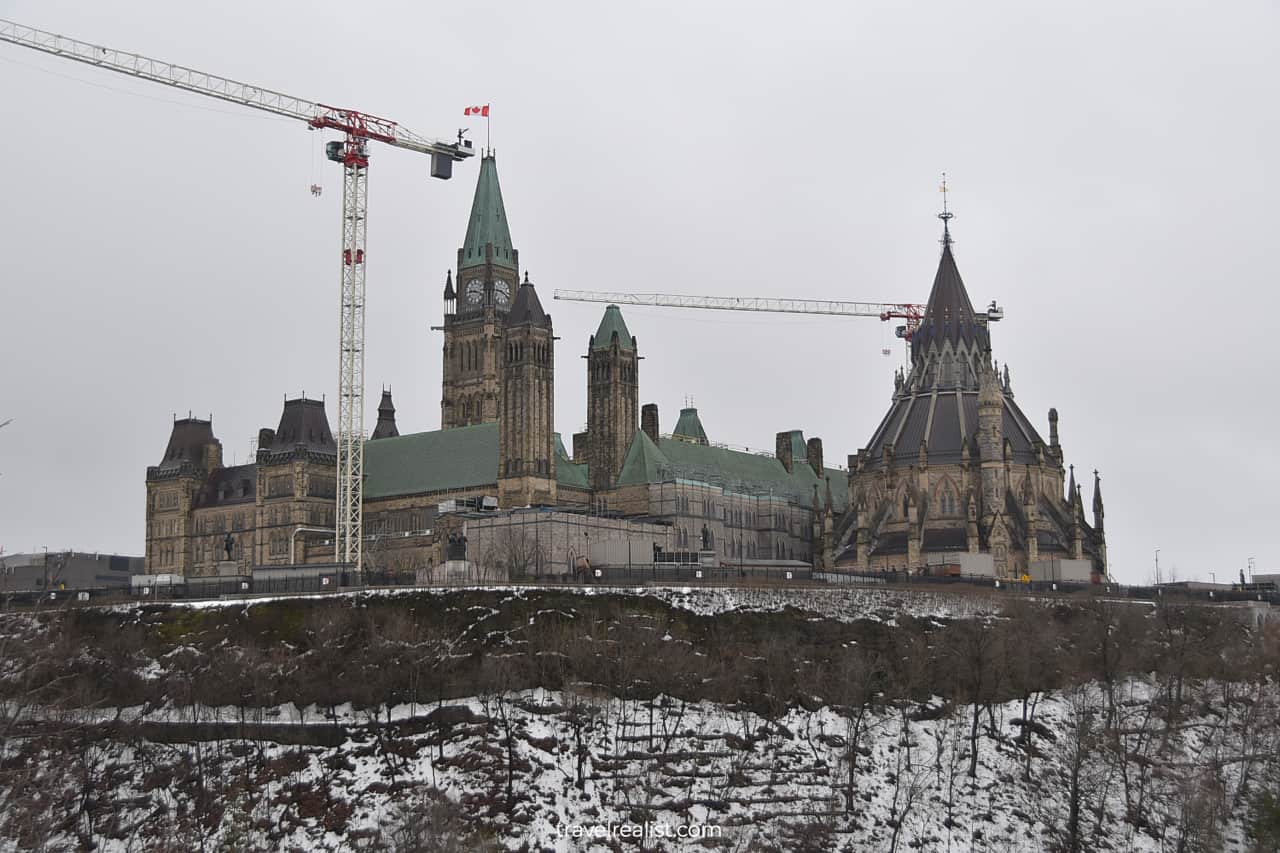
2. Parliament of Canada
The Center Block is the main building on Parliament Hill. A fire destroyed the original 1859 building. You would see the 1916 rebuild of the Center Block.
The Center Block is home to both chambers of the Canadian Parliament and the Library. But the building has been closed for renovation since 2019. Both chambers moved to other locations on Parliament Hill.
The renovation is expected to last about a decade. Until it is complete, there will be no tours of the Center Block. You could only visit an immersive exhibit at the Visitor Center.
You should make a stop at the Centennial Flame. This monument consists of a water fountain and a gas flame. It opened in 1967 on the 100th anniversary of the Canadian Confederation.
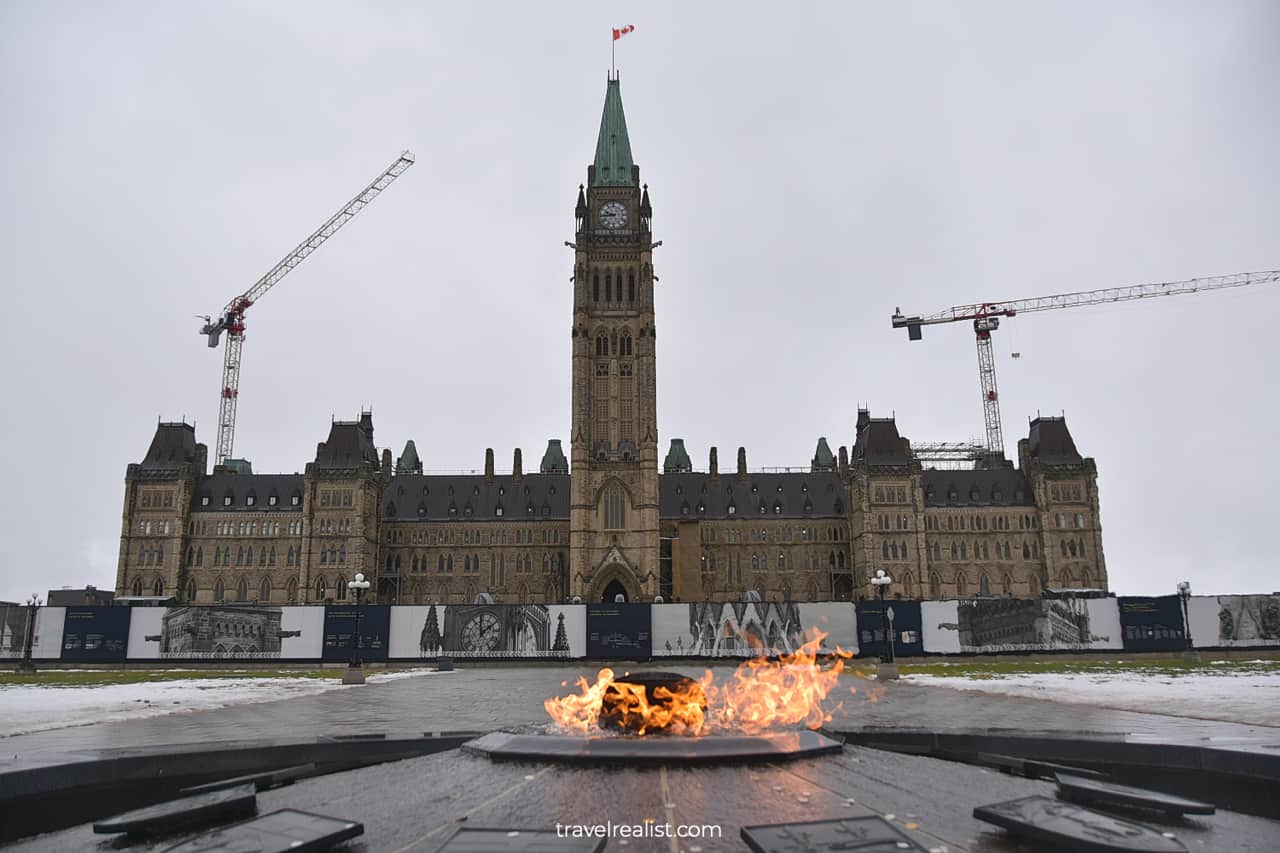
3. East Block
The East Block should be the second stop on your self guided walking tour of Ottawa. This Victorian High Gothic building dates back to 1866. Its green roof sets it apart from other Parliament Hill structures.
But the East Block has been in the shadow of its neighbors. Most visitors would recognize the Center Block and the West Block. This is not the case with the East Block.
A short tour season might be to blame for this development. You could only take a guided tour of the East Block from June to September. The 50-minute tour covers four rooms.
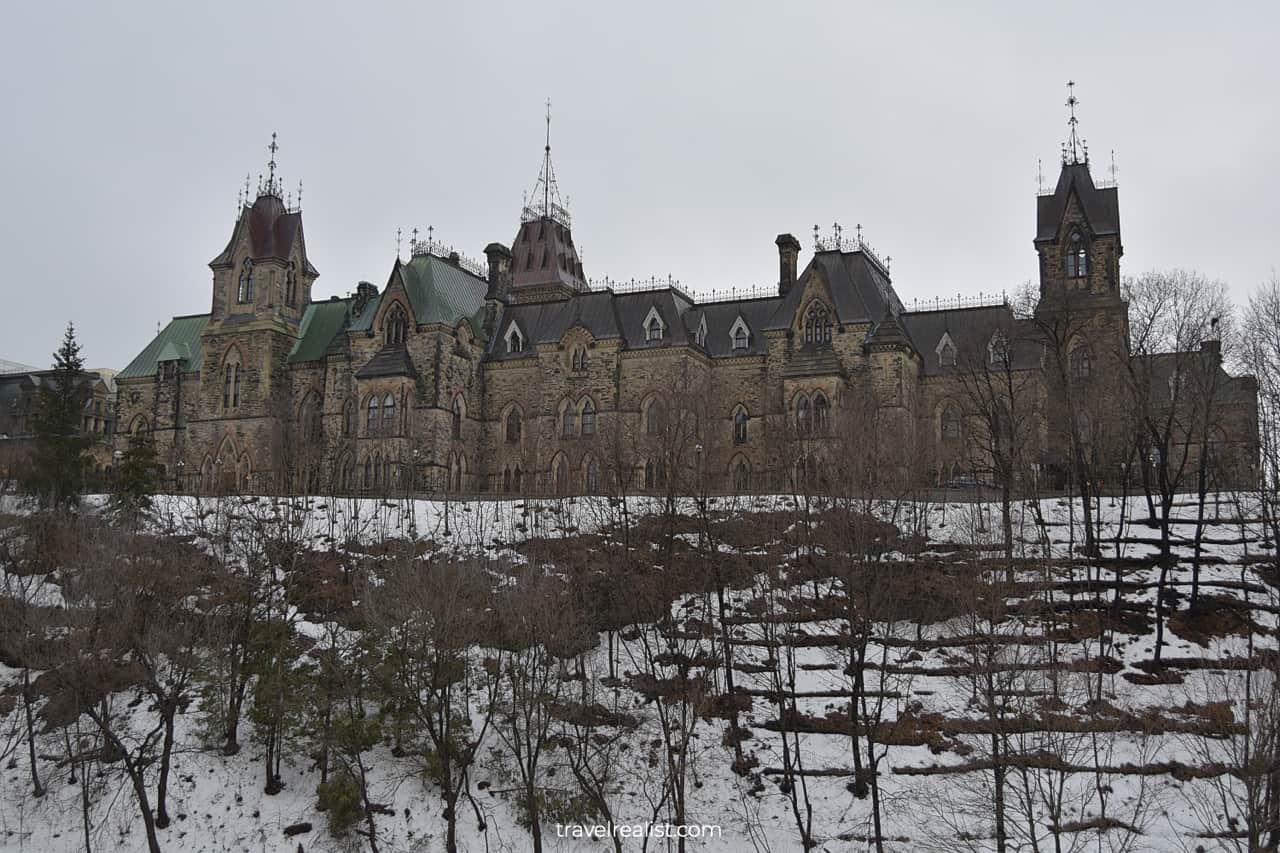
4. House of Commons
The West Block is home to the House of Commons. It is a natural stop when exploring Parliament Hill in Ottawa on foot. This building dates back to 1865.
The West Block underwent extensive renovation over the 2010s. This work is now complete. The House of Commons is open to the public throughout the year.
You could join a 40-minute guided tour of this historic building. The tour times start at 8:45 a.m. and finish at 4:40 p.m. Book your tour in advance and arrive early to clear security.
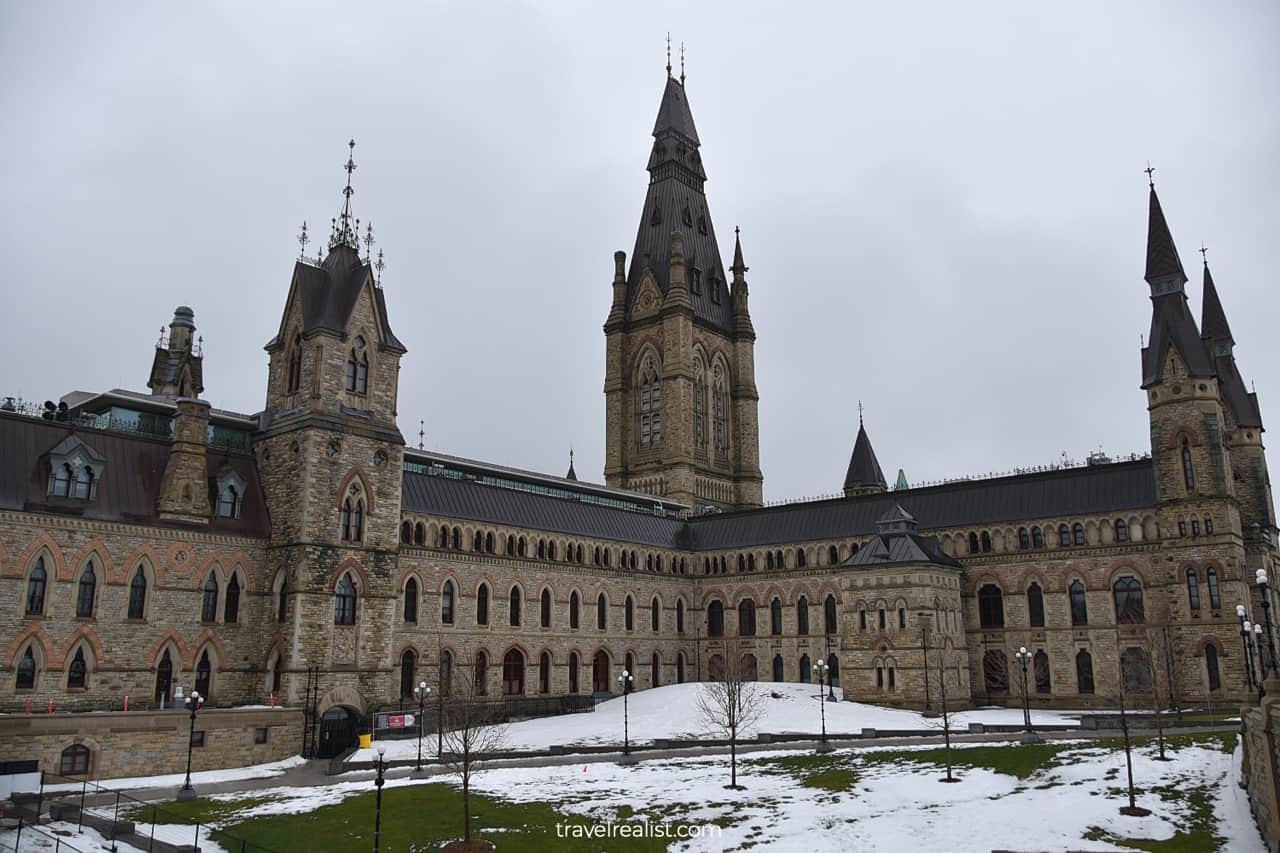
5. Confederation Building
A short walk downhill from the House of Commons will bring you to the Confederation Building. This 1932 building has a tower and two wings. The green roof color makes it a bit similar to the East Block.
Despite its beauty, this building is just a government office to this day. A handful of Members of Parliament have their offices in the Confederation Building.
The status of the building makes public tours impossible. You are left to enjoy its stunning design from the outside.
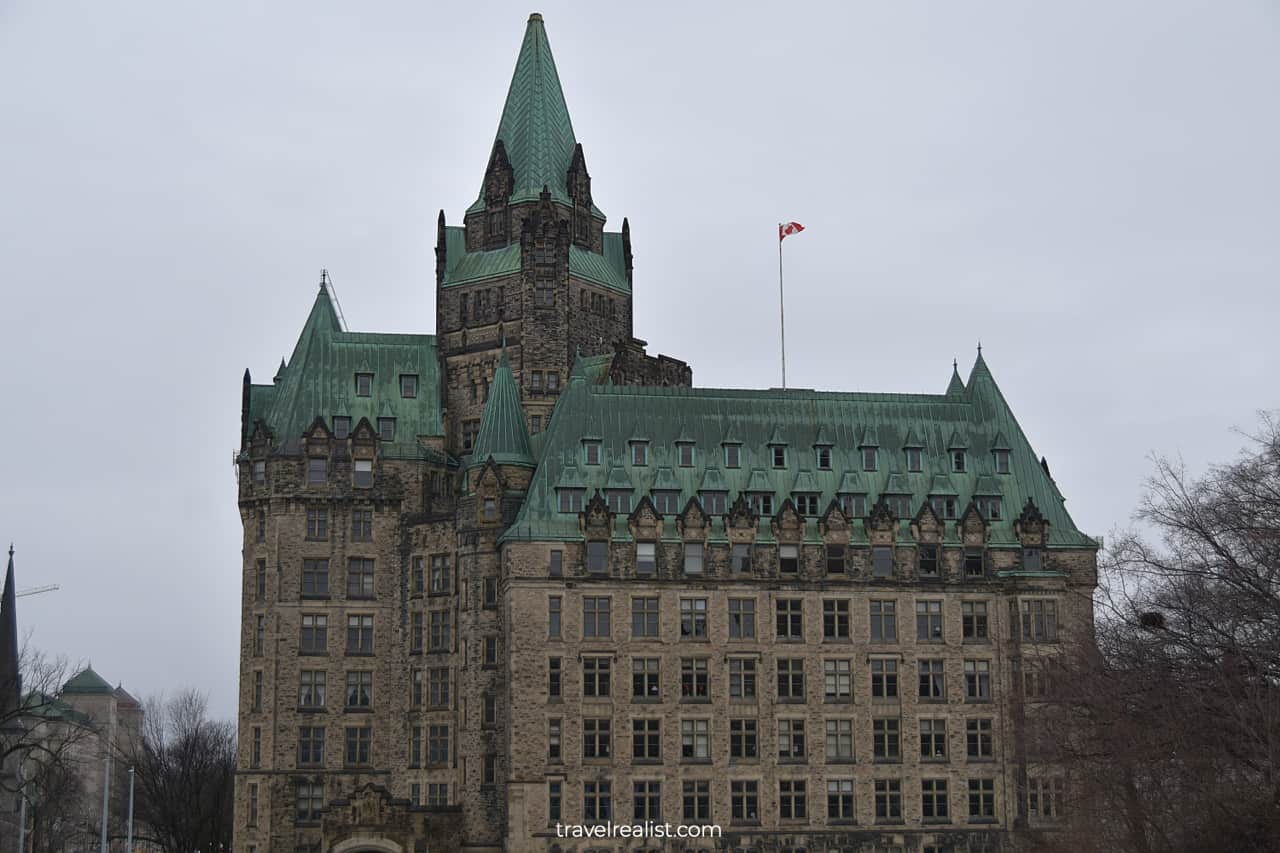
6. Justice Building
The same description applies to the Justice Building, the next stop on your self guided walking tour of Ottawa. The buildings share the same architect and Gothic Revival style.
But the Justice Building does not have as high of a tower and wings as its neighboring building. This structure dates back to 1938.
You could get a good look at the Justice Building from the nearby lawn. It also means that you arrived at the Supreme Court of Canada.
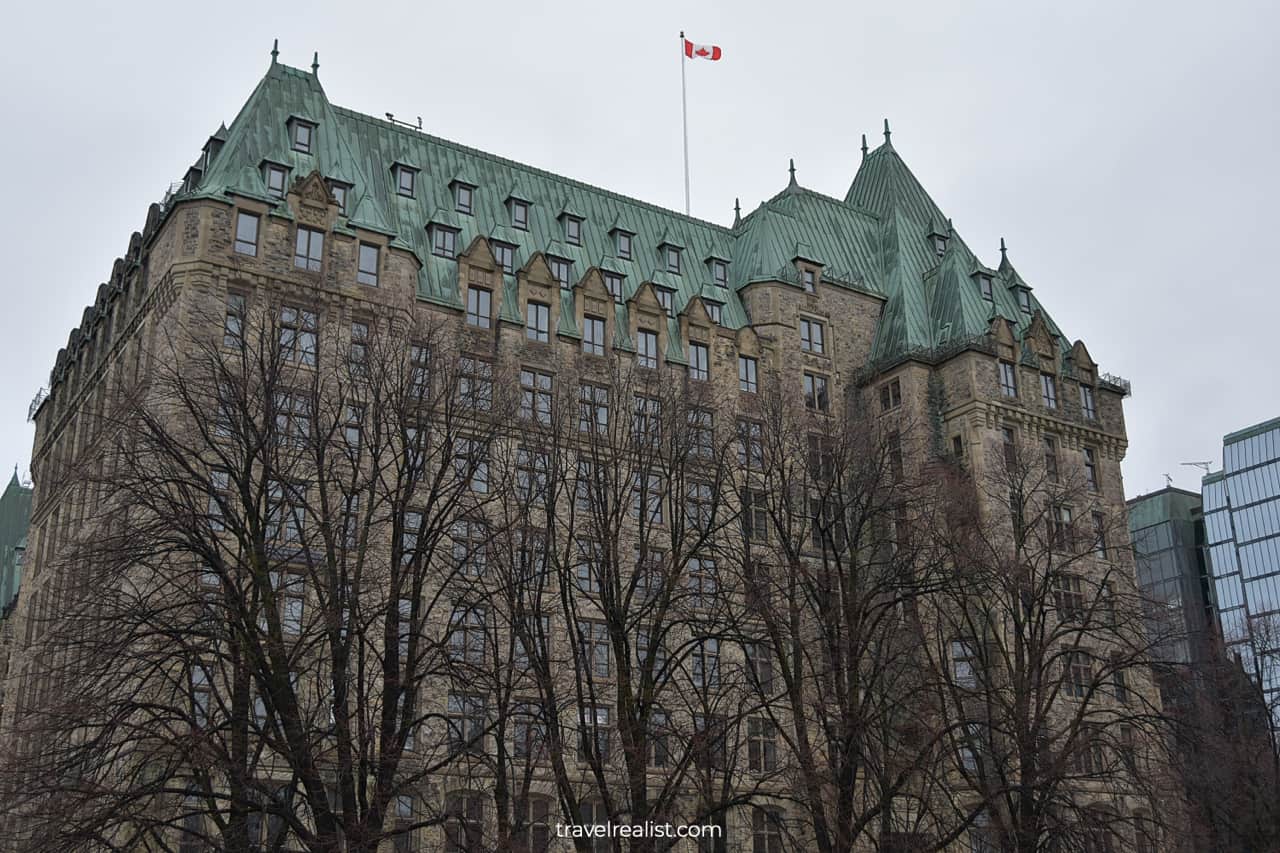
7. Supreme Court of Canada
The Supreme Court of Canada is the westernmost stop on your self guided walking tour of Ottawa. The name says it all: this building houses the highest court in the country.
The Art Deco building with Châteauesque roof dates back to 1946. You could take a guided tour of the Supreme Court from September to April. It is open to the public from 9 a.m. to 5 p.m. Monday to Friday.
A 30-minute free tour will give you a chance to see the interior of the building. Book your spot well in advance. You might even attend a court session!
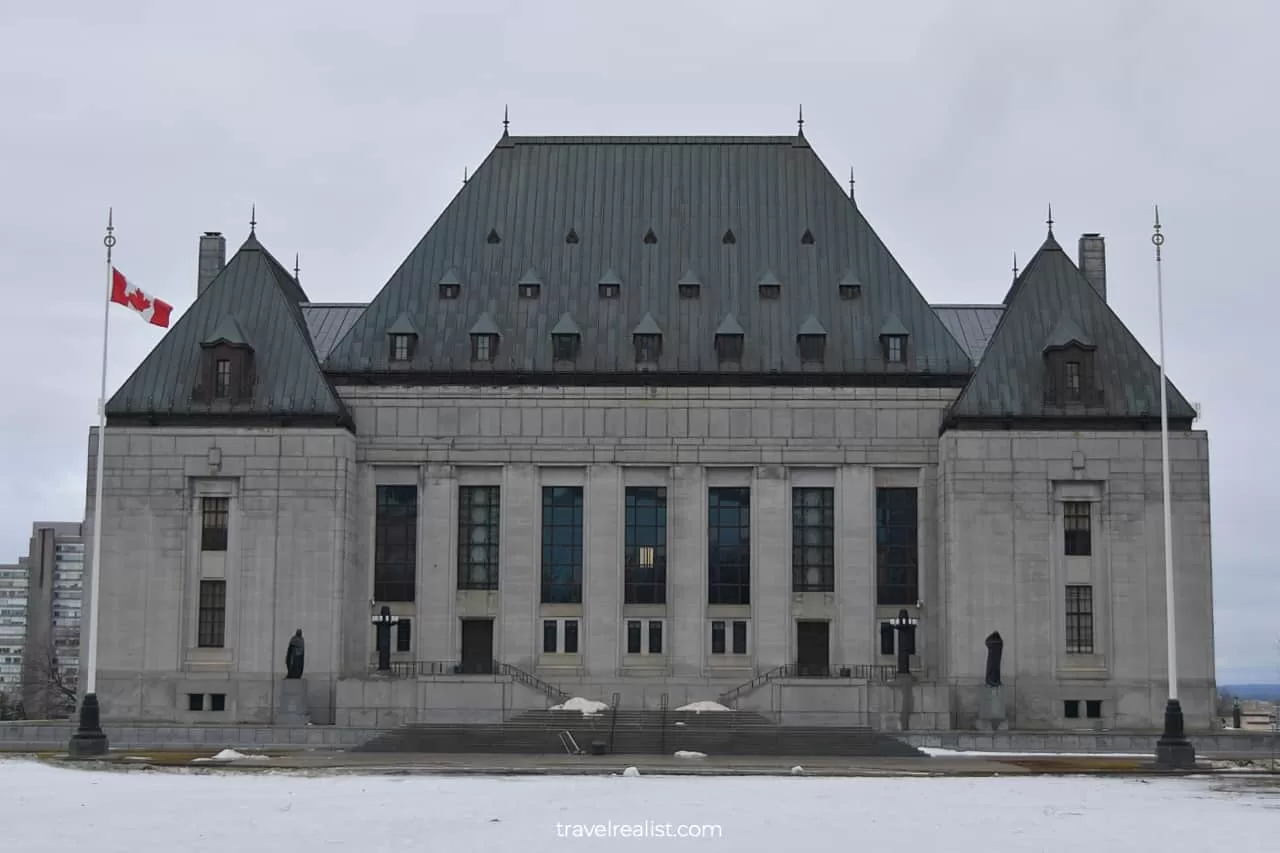
8. St. Andrew’s Church
The lawn in front of the Supreme Court of Canada takes up an entire block. You will see St. Andrew’s Presbyterian Church on its other side.
The 1857 church is next to the government offices. Such proximity is very common on university campuses in the United States. Harvard University and the University of Chicago have similar setup.
You could visit the church from 9 a.m. to 12:30 p.m. on weekdays. The church is open from 10:30 a.m. to 1 p.m. on Sundays. But it is closed on Saturdays.
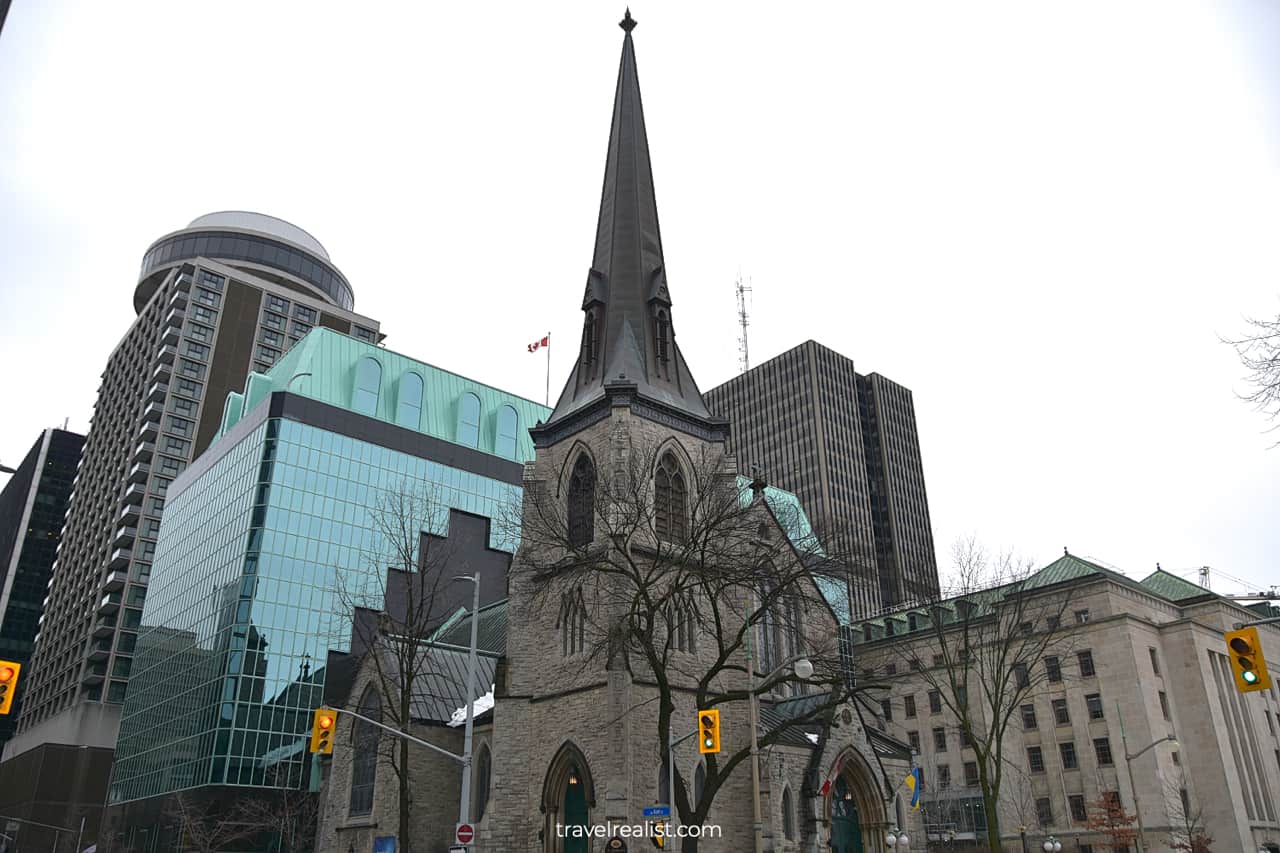
9. Bank of Canada
The Bank of Canada Building is a great next stop on the self guided walking tour of Ottawa. It is across the street from both St. Andrew’s Presbyterian Church and the Confederation Building.
The current Bank of Canada Building is a combination of two buildings. The first is a 1938 Neoclassical building. Its grey granite looks a lot like the buildings in Manhattan in New York City.
A 1979 glass building is behind the older structure. The newer building takes over the view. It makes the original structure look small.
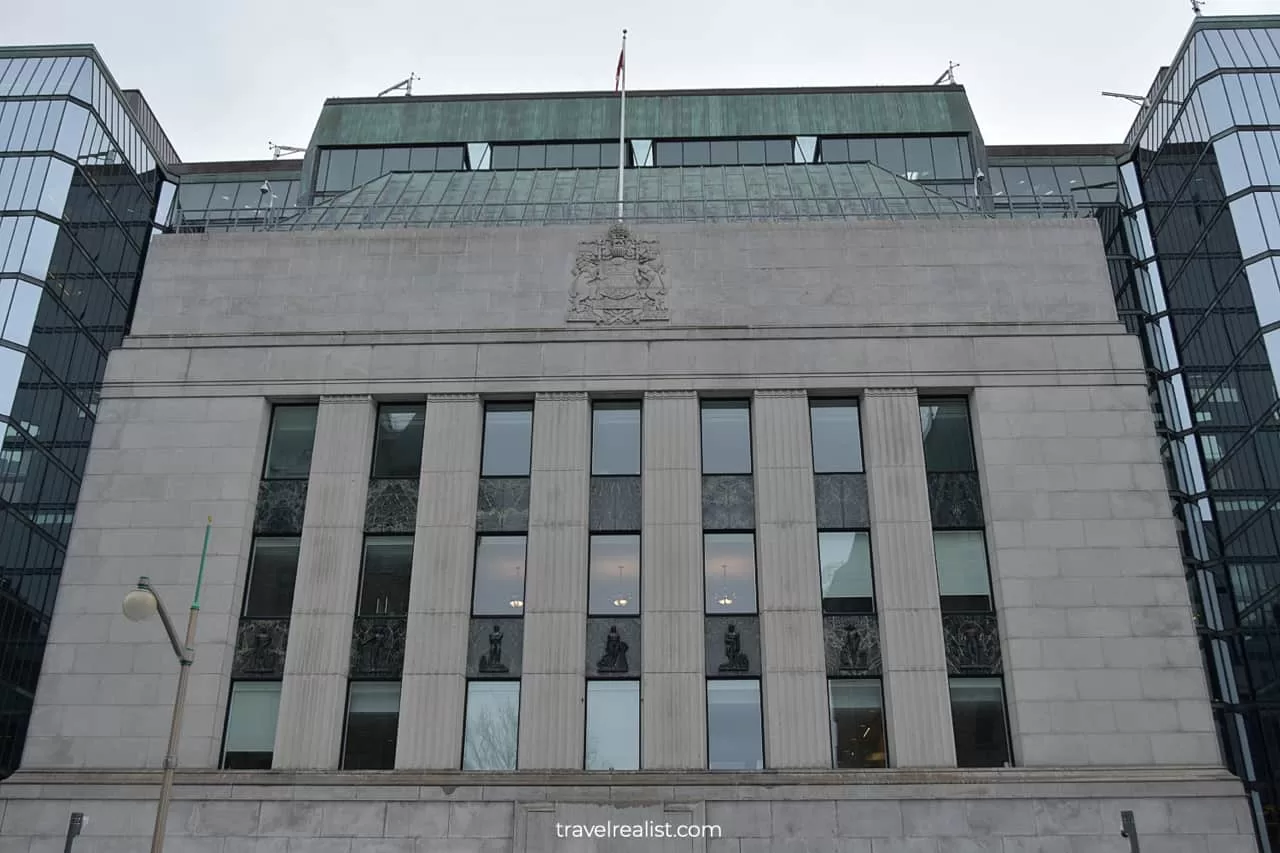
But there are some positives about the glass structure. It is perfect for capturing reflections. You could even see the tower of the nearby Confederation Building.
You cannot go inside the Bank of Canada Building. But there is a small museum next to it. This free museum is open from 10 a.m. to 5 p.m. Thursday to Monday.
You will certainly remember its pyramid structure. Head there to see the Canadian currency and learn more about the functions of the bank.
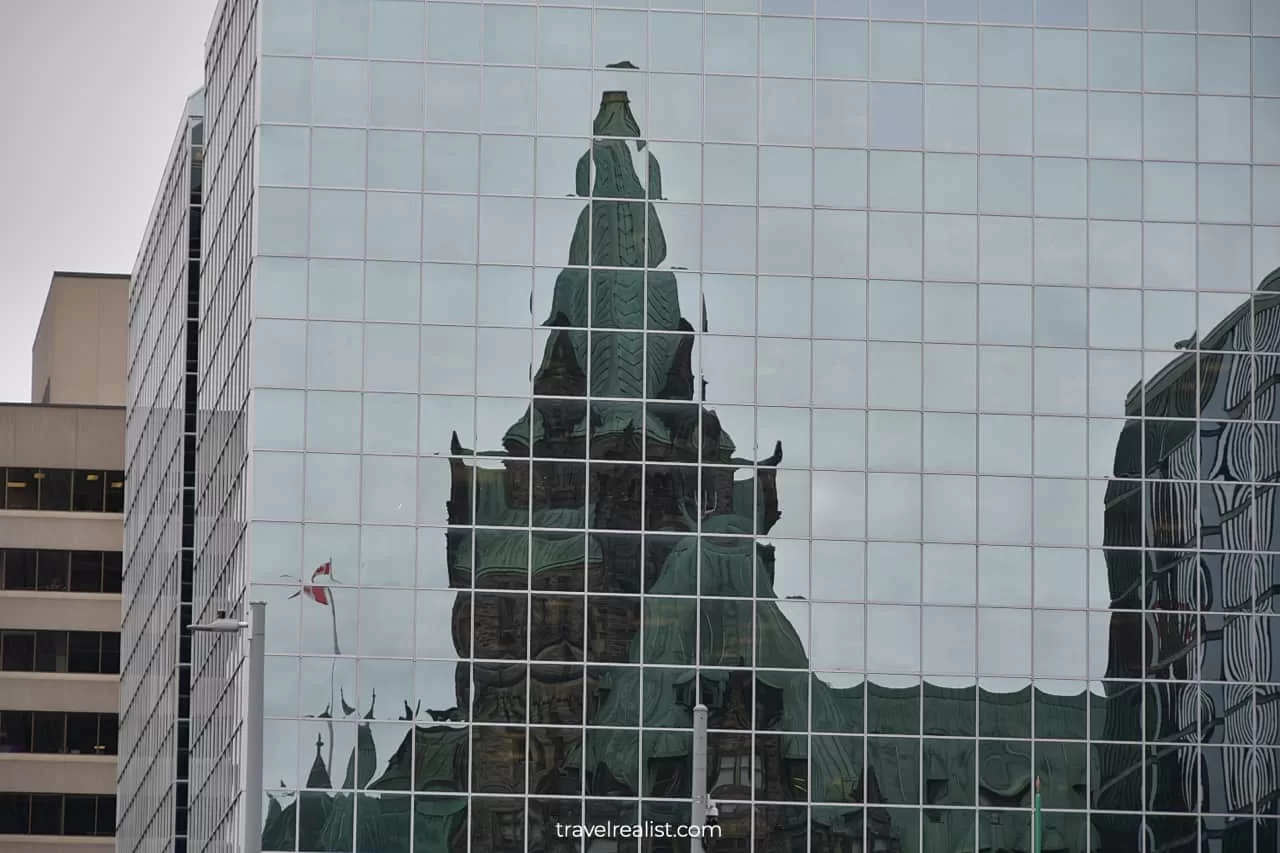
10. Indigenous Peoples Building
The self guided walking tour of Ottawa continues east along Wellington Street. You will pass the House of Commons and arrive at the Centennial Flame. Turn around and take a look at a three-story building.
This structure follows a similar Beaux-Arts style to the Vanderbilt Mansion and Mills Mansion in Hyde Park, New York. The building was home to the United States Embassy in Canada when it opened in 1931.
It houses the Indigenous Peoples Building since 2017. Most of its windows have colorful digital displays. Until the renovations are complete, you could enjoy the rotating exhibits from the street.
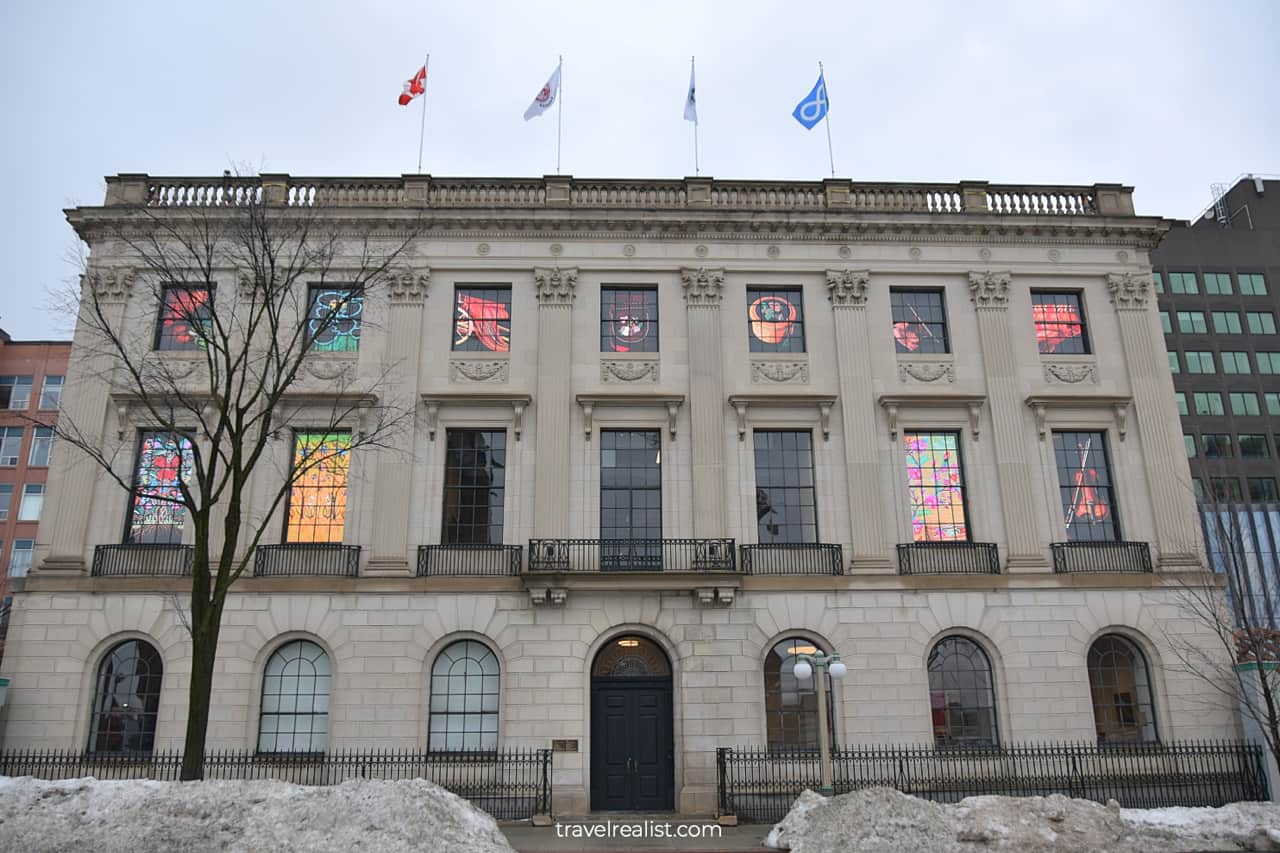
11. Office of the Prime Minister
You will find the Office of the Prime Minister and Privy Council Building next to the Indigenous Peoples Building. It is a Second Empire building that dates back to 1889.
This structure is the only building on Parliament Hill built in this style. It carried the name of Langevin Block until its renaming in 2017.
The Office of the Prime Minister and Privy Council is an active government building. As a result, your exploration would be limited to the facade.
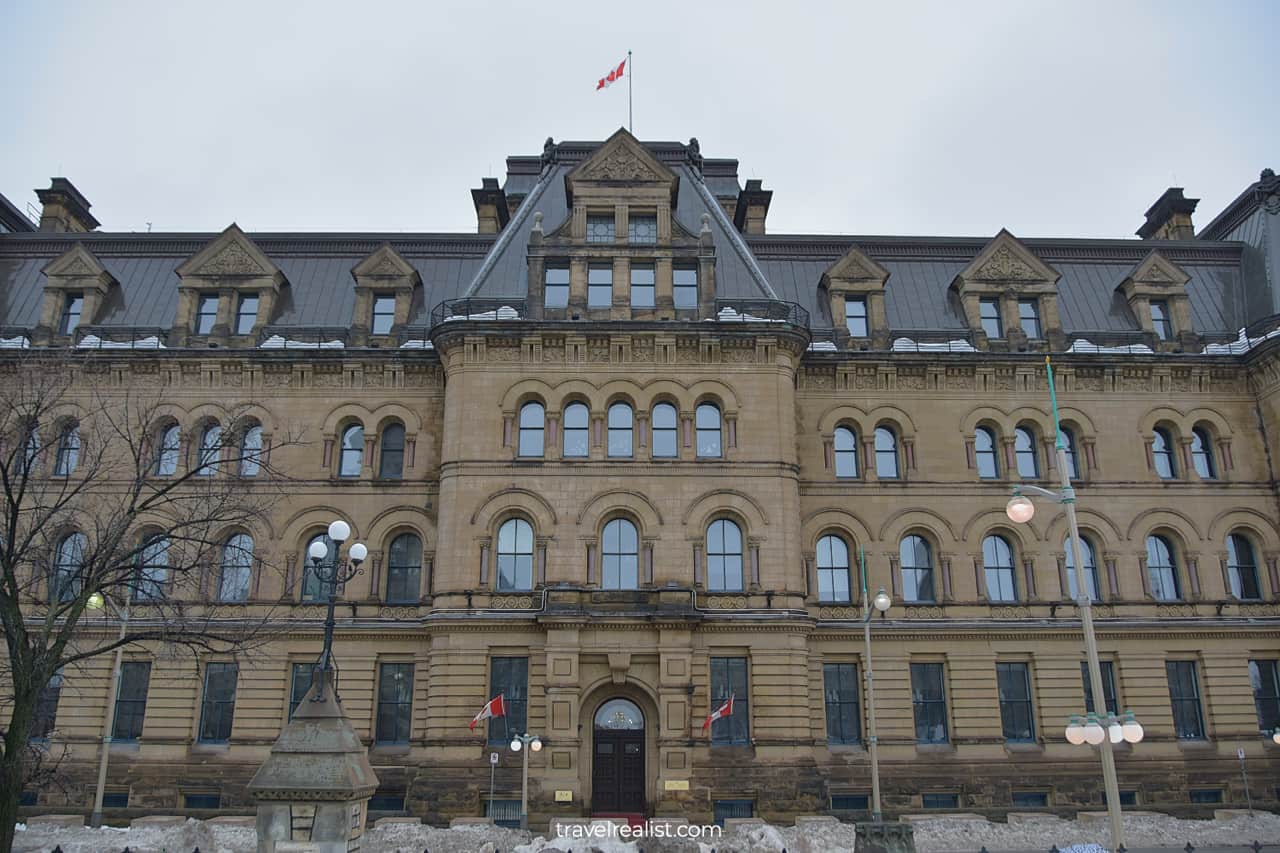
12. Rideau Canal
The self guided walking tour through Ottawa will bring you to the Rideau Canal next. You will see the very beginning of this canal. Its Locks 1-8 are between the East Block and Fairmont Château Laurier.
The Rideau Canal is 125 miles (202 km) long. It connects the Ottawa River in Ottawa with the St. Lawrence River in Kingston. There are 46 locks on the Rideau Canal.
The canal dates back to 1832, a similar time the Morris Canal was opened in New Jersey. But in contrast to its peer in the United States, the Rideau Canal remains in use for recreational boating.
If weather permits, the Rideau Canal becomes the largest skating rink in the world each January and February. A 4.8-mi (7.8-km) section of the canal attracts thousands of skaters then.
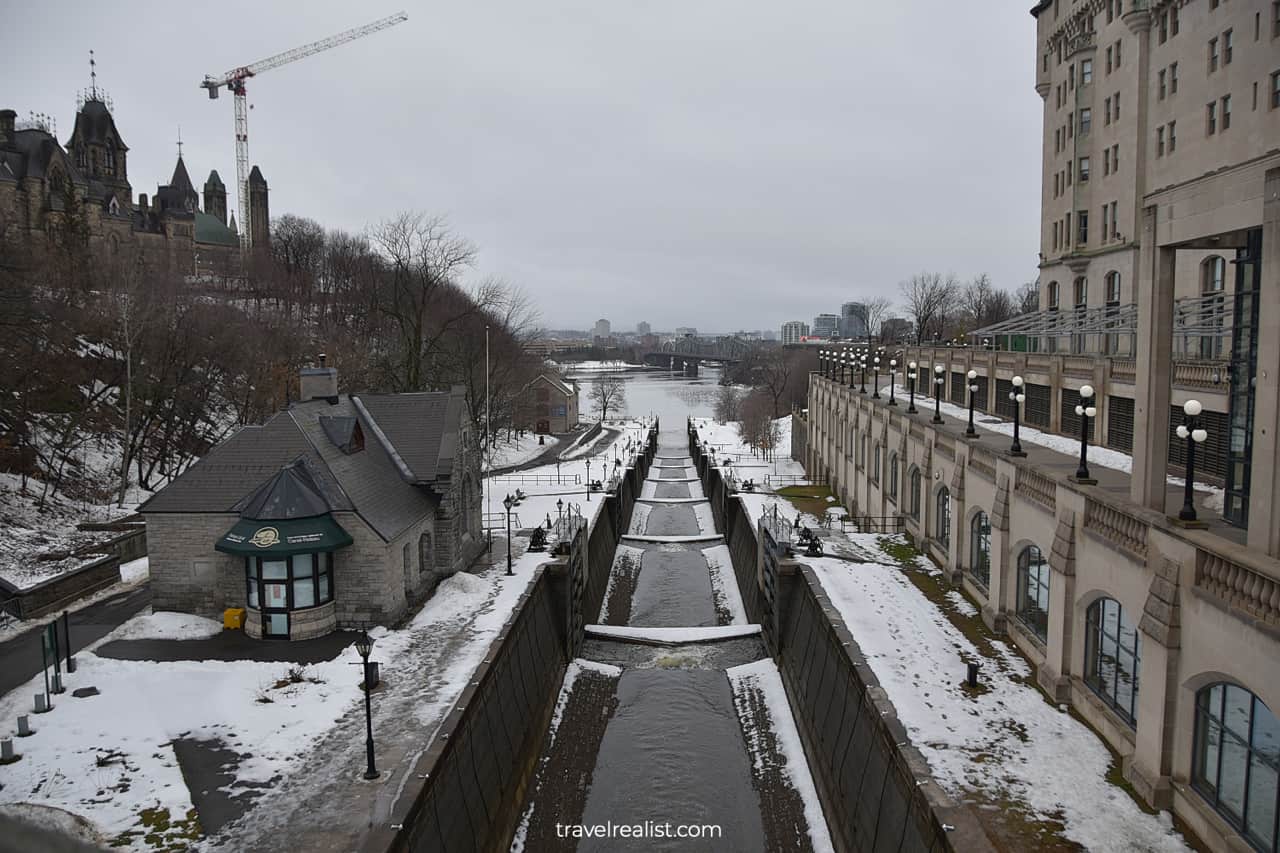
13. Fairmont Château Laurier
The Fairmont Château Laurier is the next stop on your self guided walking tour of Ottawa. This luxurious hotel dates back to 1912. It displays Gothic Revival Châteauesque style and looks a bit like a castle.
You might even find some common elements with the Gifford Pinchot House in Pennsylvania. Look for the original stained glass windows and plaster decorations.
The 4-star hotel houses 429 rooms. You could admire the building from the outside free of charge. But you would need to book a room to explore its interior. It is a common way to explore historic hotels.
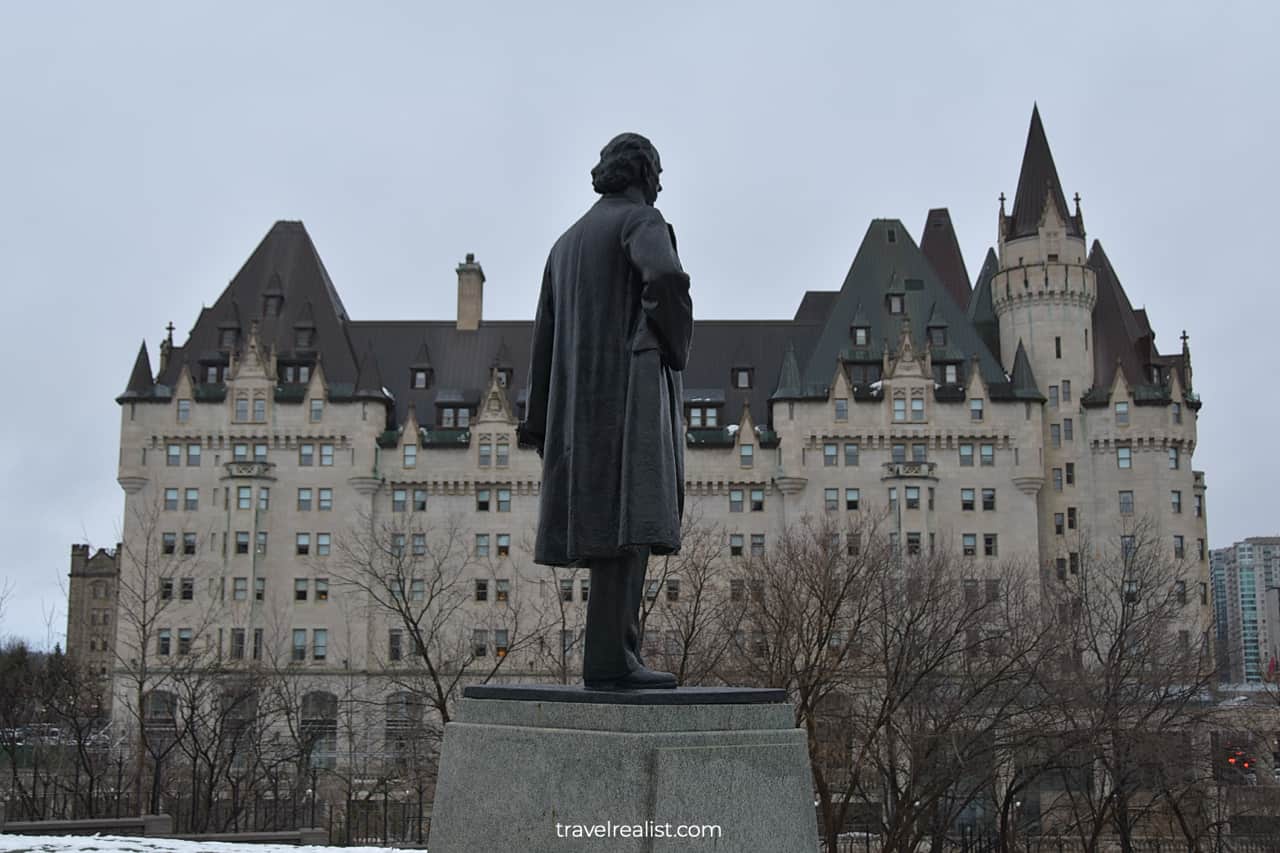
14. Senate of Canada
You will arrive at the Senate of Canada Building by crossing the street from the historic hotel. This 1912 building has a long history. As a matter of fact, it was not a government building until quite recently.
Instead, this building housed the main railway station from 1912 until 1966. The residents of the city knew it as Ottawa Union Station back then. The tracks were removed in 1966 in favor of a scenic drive.
The building became a Government Conference Center. The Senate moved here until the restorations are complete at the Center Block. You could take a 30-minute guided tour of this building.
Make sure to book your free tour in advance. Similar to other Parliament Hill buildings and the Statue of Liberty, you would need to pass a security screening first.
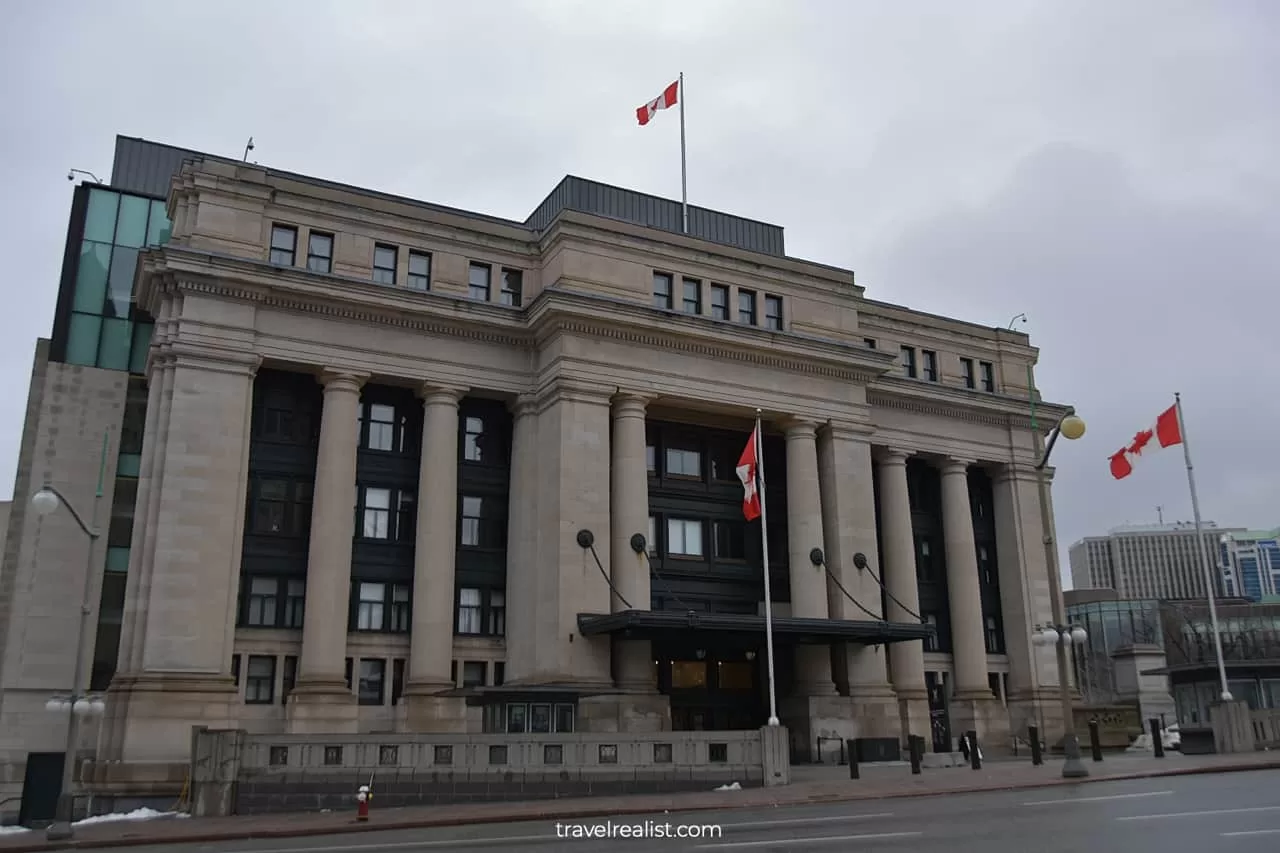
15. Connaught Building
Consider turning left on Sussex Drive as you continue your self guided walking tour through Ottawa. You will find yourself in ByWard Market neighborhood.
The Connaught Building could be the next stop on your journey. This Tudor-Gothic building dates back to 1913. Despite being younger than most buildings on the Parliament Hill, it carries a protected status.
The Connaught Building houses Canada Revenue Agency. As a result, you could only admire it from the outside. There are irregular tours of the Mackenzie Lobby Area and 8th floor executive boardroom.
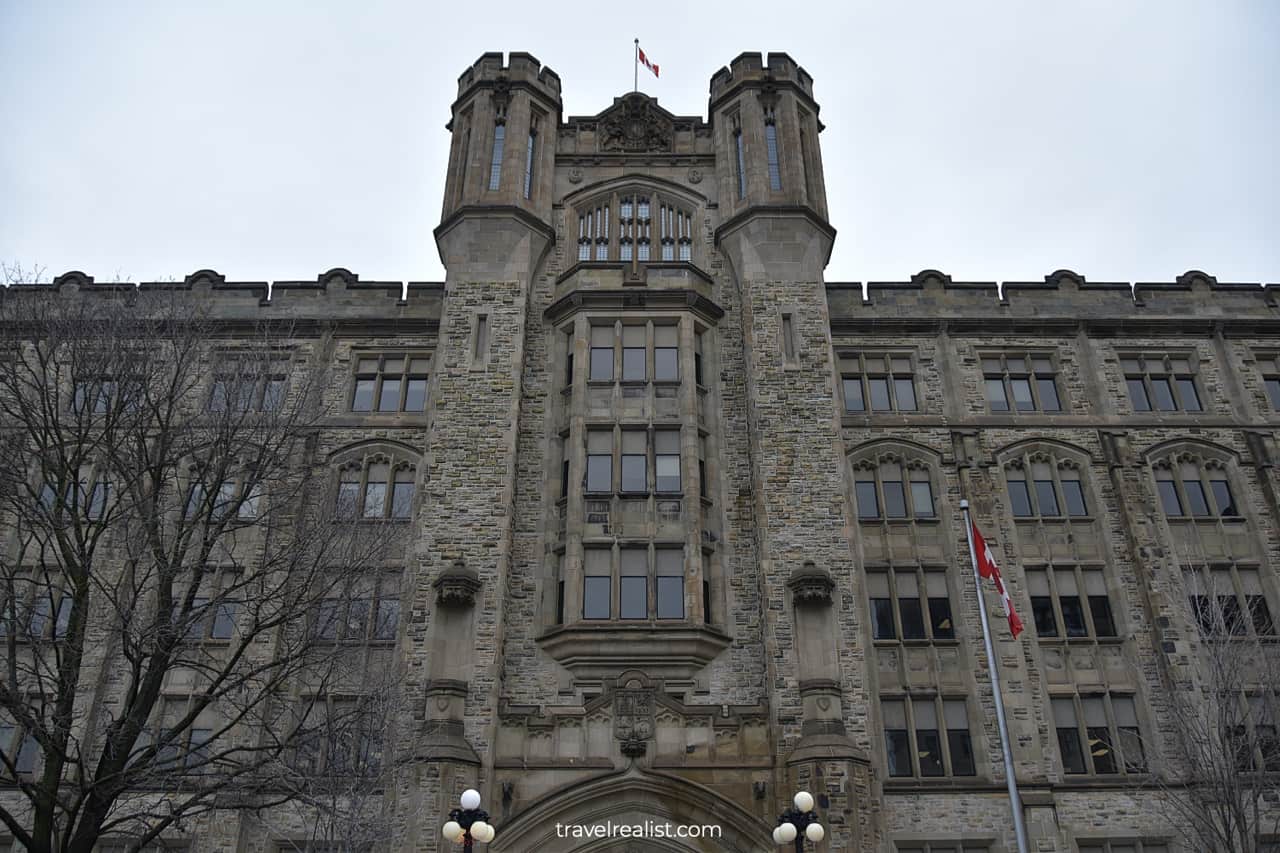
16. Notre-Dame Cathedral Basilica
As you make your way north through ByWard Market neighborhood, you will arrive at the Notre-Dame Cathedral Basilica. The cathedral is one of the symbols of the city.
This historic church dates back to 1865. It is also a National Historic Site after the extensive restoration efforts in the 1990s.
The cathedral is a beautiful example of Neoclassical and Gothic Revival styles. Get ready to be amazed by the ornamental interior of the Notre-Dame Cathedral Basilica.
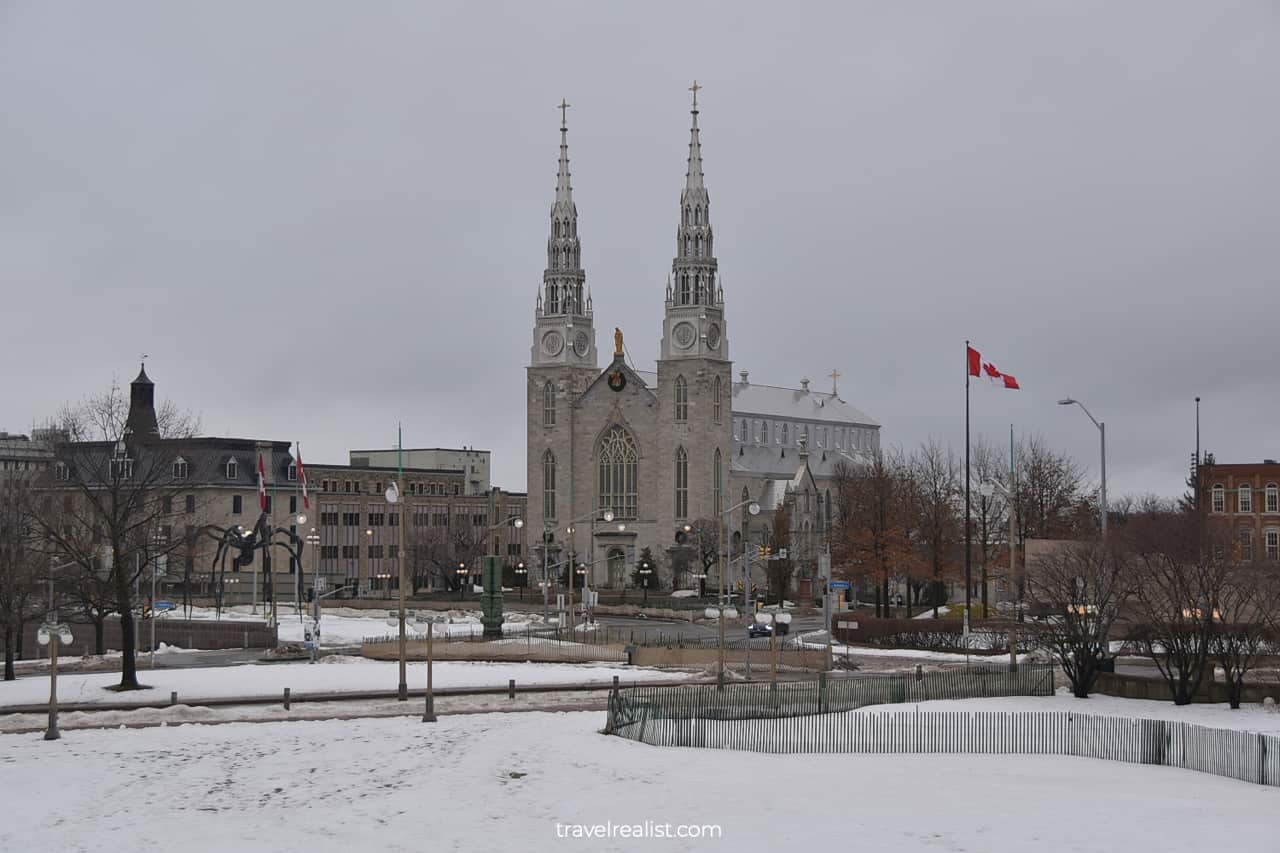
The cathedral is open to visitors every day from 9 a.m. to 6 p.m. Weekend hours extend to 7 p.m. The hours might change during religious holidays and events. You could visit the church free of charge.
The Notre-Dame Cathedral Basilica is an active church. Be respectful to the churchgoers. Daily masses take place at 12:15 p.m. on weekdays. There are 2 masses on Saturdays and 3 masses on Sundays.
You could also take a guided tour of the cathedral. The tours run from 2 p.m. to 5 p.m. Wednesdays and Thursdays and from 3 p.m. to 5 p.m. on Saturdays. A spot costs $10 CAD (~$7.5 USD) per person.
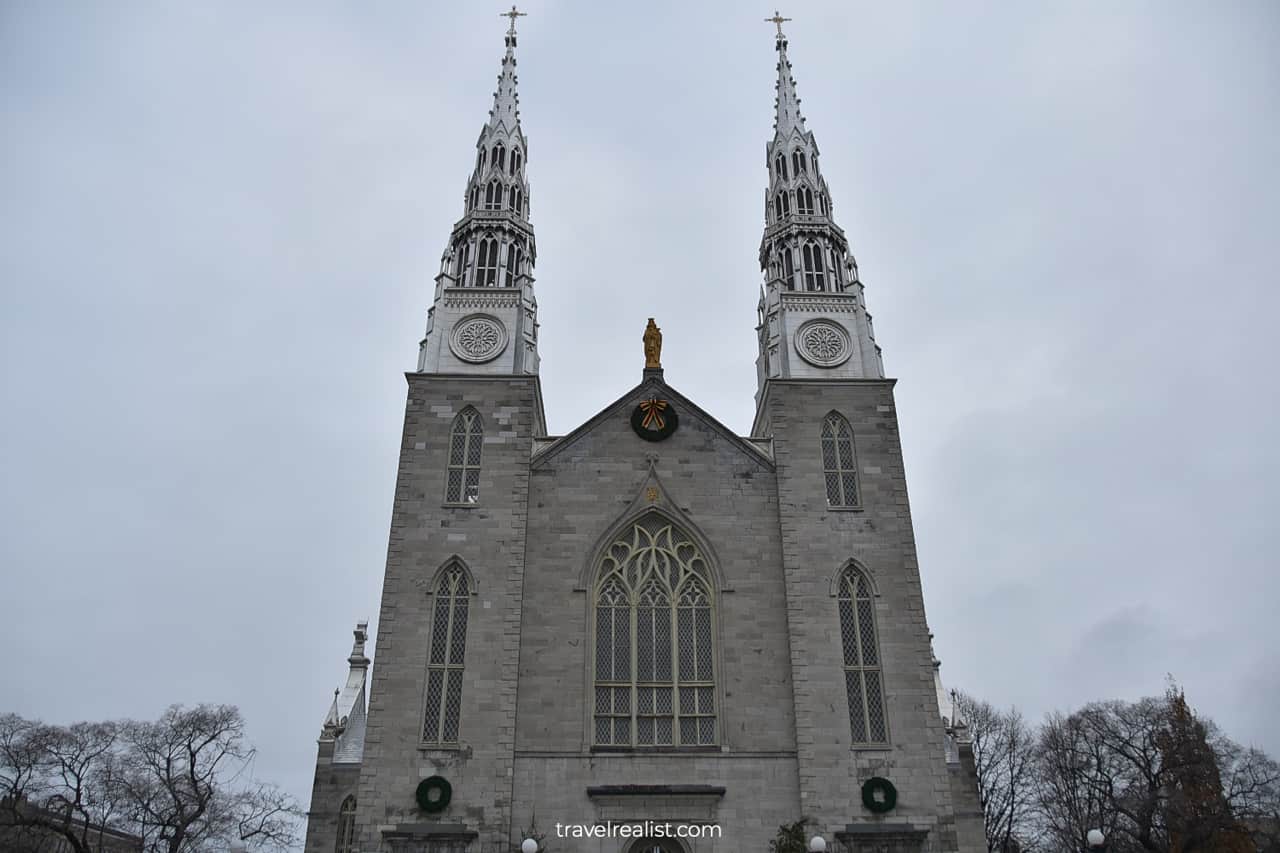
17. National Gallery of Canada
The first museum on your self guided walking Ottawa tour is across the street from the Notre Dame Cathedral Basilica. The National Gallery of Canada is one of the largest art museums in North America.
You are certain to notice a large Maman sculpture in front of the Gallery. The museum dates back to 1880. Some 100 years later the gallery moved to its current building.
The National Gallery of Canada is open from 10 a.m. to 5 p.m. Tuesday to Sunday year round. Admission is $20 CAD (~$15 USD) for adults. There are discounts for seniors, youth, families, and children.
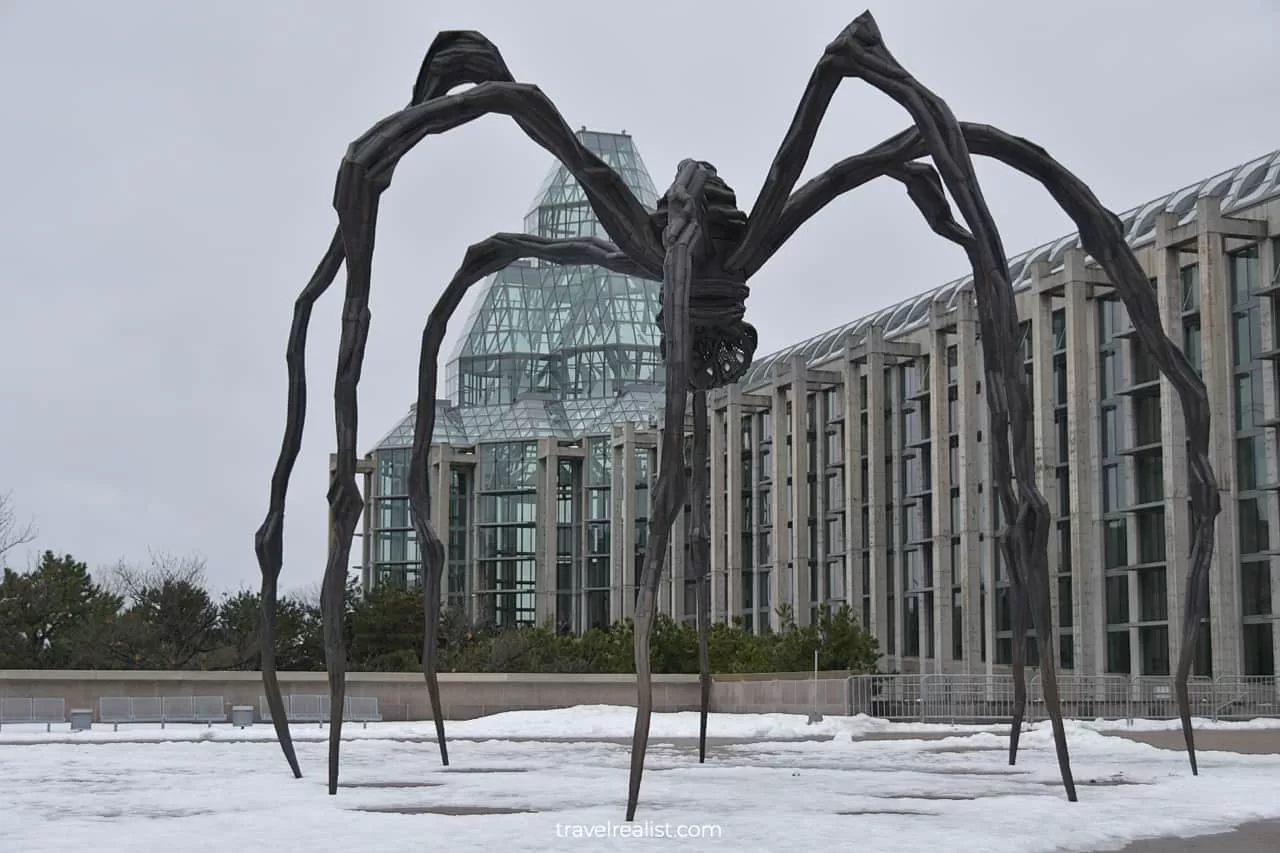
18. Laurier House
If you would like to extend your self guided walking tour of Ottawa, you should go to Laurier House. The mansion is a 1.2-mi (2-km) walk from Notre Dame Cathedral Basilica and National Gallery of Canada.
This 1878 house was a residence of two Prime Ministers of the country. It now serves as a National Historic Site and a house museum.
Like most museums in Kingston, Ontario, Laurier House is only open from May to September. You could tour the house for $4.5 CAD (~$3.3 USD) per adult. Seniors pay $4 CAD (~$3 USD). Youth visit free.
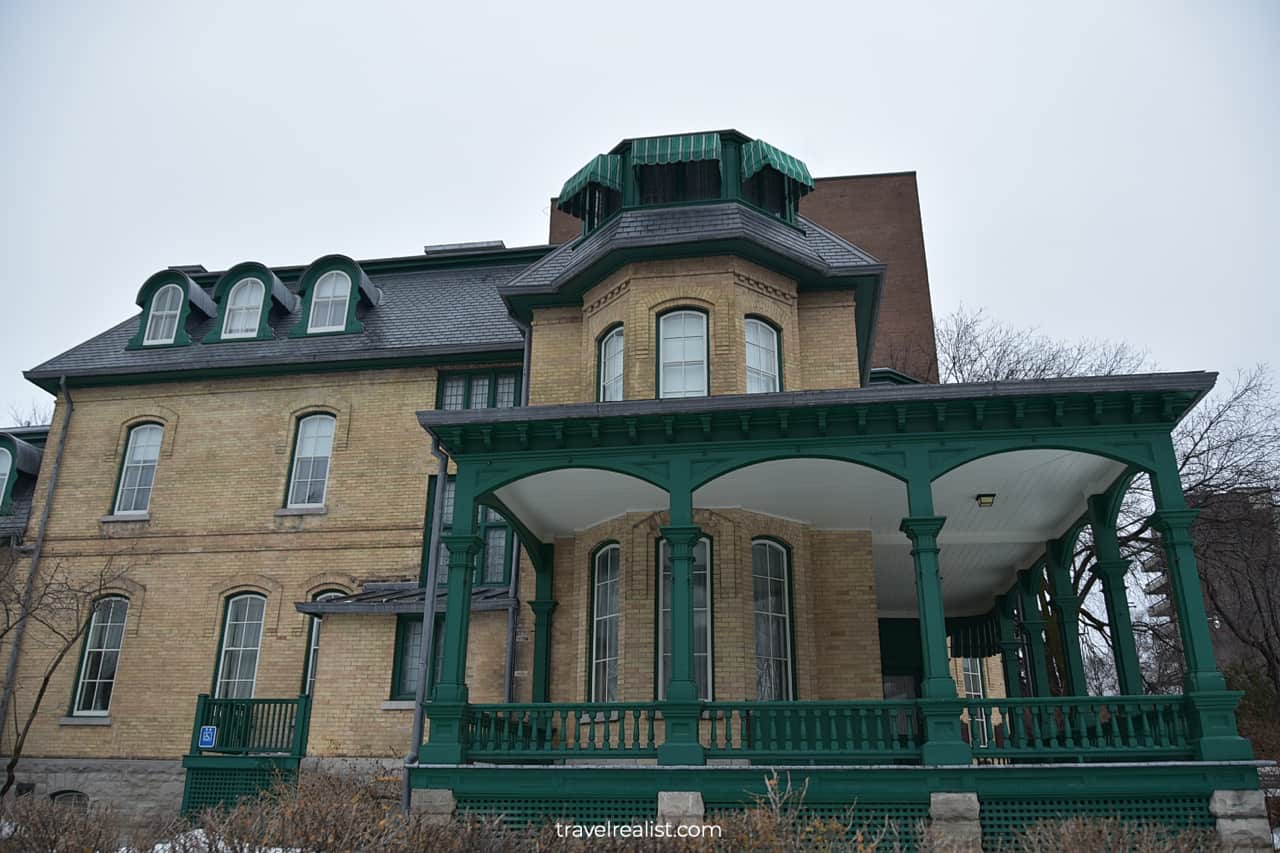
Continue with this Ottawa Self Guided Walking Tour Guide. You will learn more about ways to get to the sights, entrance requirements, and places to stay.
Getting to Ottawa, Canada
Ottawa is the capital of Canada. The city is in Ontario on the south bank of the Ottawa River. Together with Gatineau in Quebec across the river, it forms the National Capital Region.
Despite being the capital of the country, Ottawa is not the largest or most populous city in Canada. This fact brings a few challenges to travelers to Ottawa.
Flights
There are few direct flights to the capital (YOW). Even Vancouver has more flights abroad. But it does not makes sense to fly to British Columbia or Alberta when visiting Ottawa.
As a result, a trip to Ottawa often involves a connection. On the bright side, you could often find a cheaper flight to Toronto (YYZ) and Montreal (YUL).
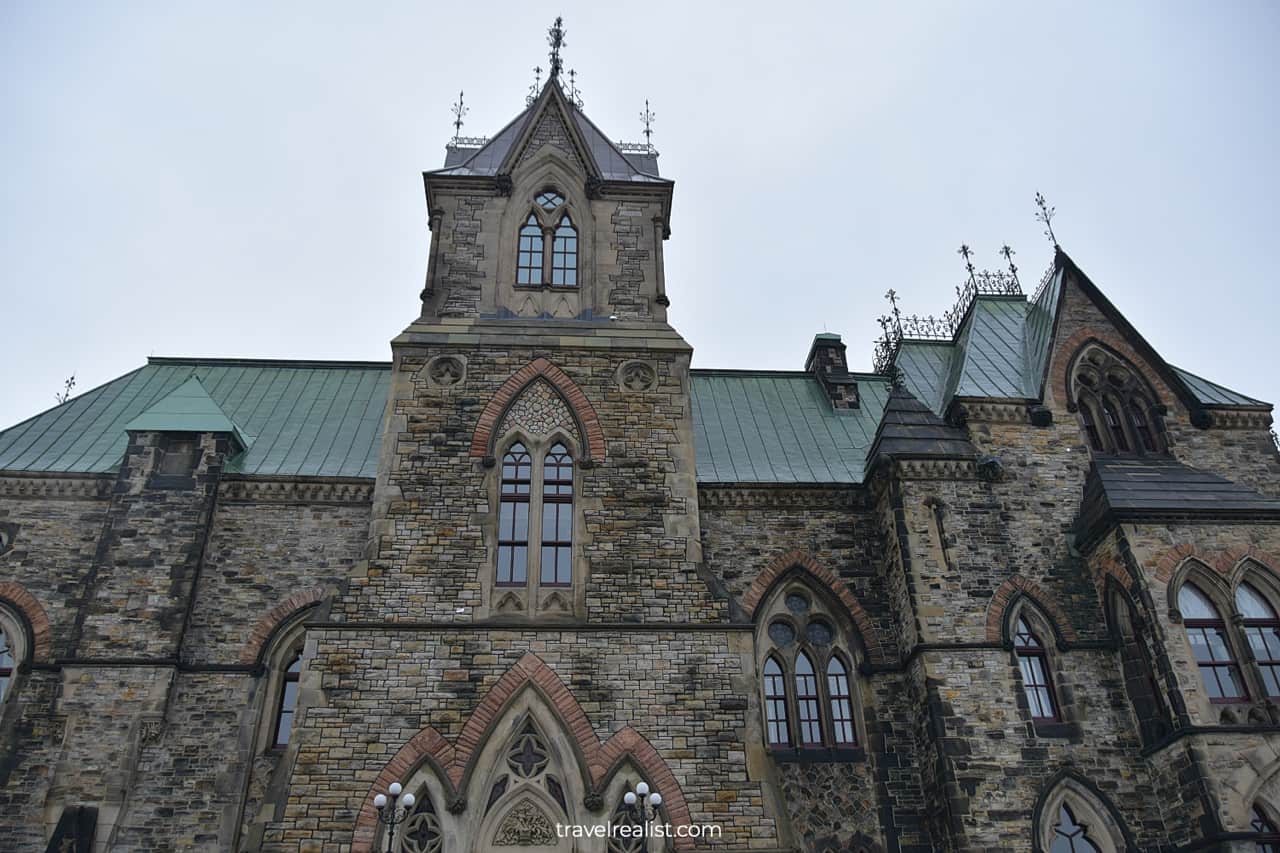
Car or Train
The latter city is a great gateway to Ottawa. You could reach the capital from Montreal in less than 2 hours by car. A trip by VIA Rail would take about 90 minutes. It costs $41 CAD (~$30 USD) per person.
You would need to budget over 4 hours to get to Ottawa from Toronto. This is true for trips by both car and train. A train ride also costs more. You should budget at least $54 CAD (~$40 USD) per person.
But there is one reason to consider Toronto as a gateway to the capital. It is the largest city in the country. In addition, Toronto Pearson (YYZ) is by far the most well connected airport in Canada.
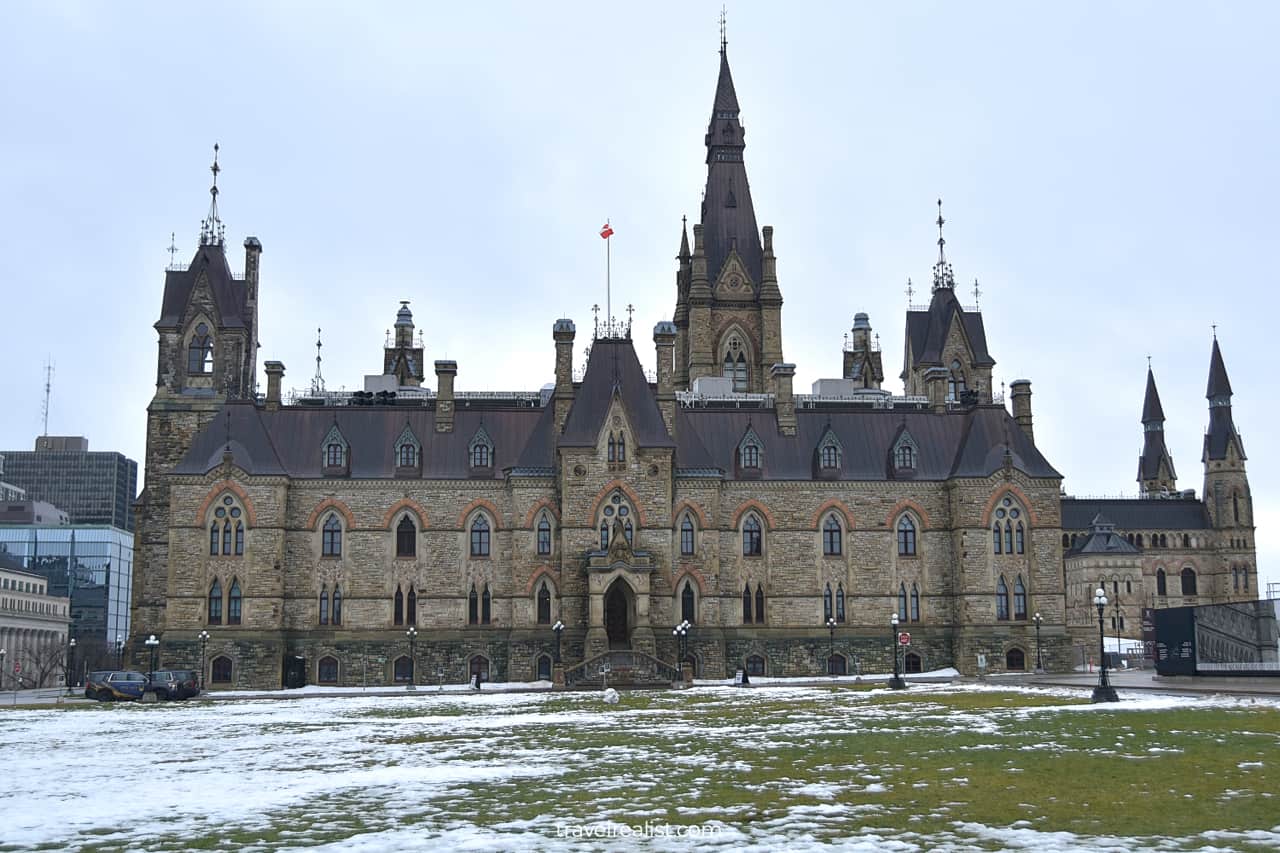
Parking
A car is the most cost effective way of reaching Ottawa from the neighboring cities. But you might regret having it if you only plan on exploring Byward Market – Parliament Hill district.
Parking could be a real problem in this city. It is both sparse and expensive. Sundays are an exception. You could park for free in some areas, like Byward Market. Still, double check the signs to avoid a fine.
Public Transport
You could get around Ottawa without a car. There is a light-rail line (O-Train). It runs through the city from East to West. It connects Parliament Hill with VIA Rail station.
You could take an O-Train from 5 a.m. to 1 a.m. on weekdays and 2 a.m. on Fridays. The trains run from 6 a.m. to 2 a.m. on Saturdays. But beware: the service is only run between 8 a.m. and 11 p.m. on Sundays.
A single ride costs $3.8 CAD (~$2.8 USD) per adult. A day pass is $11.75 CAD (~$8.75 USD). You would almost break even after 3 rides. There are also plenty of bus routes if the O-Train does not work out.
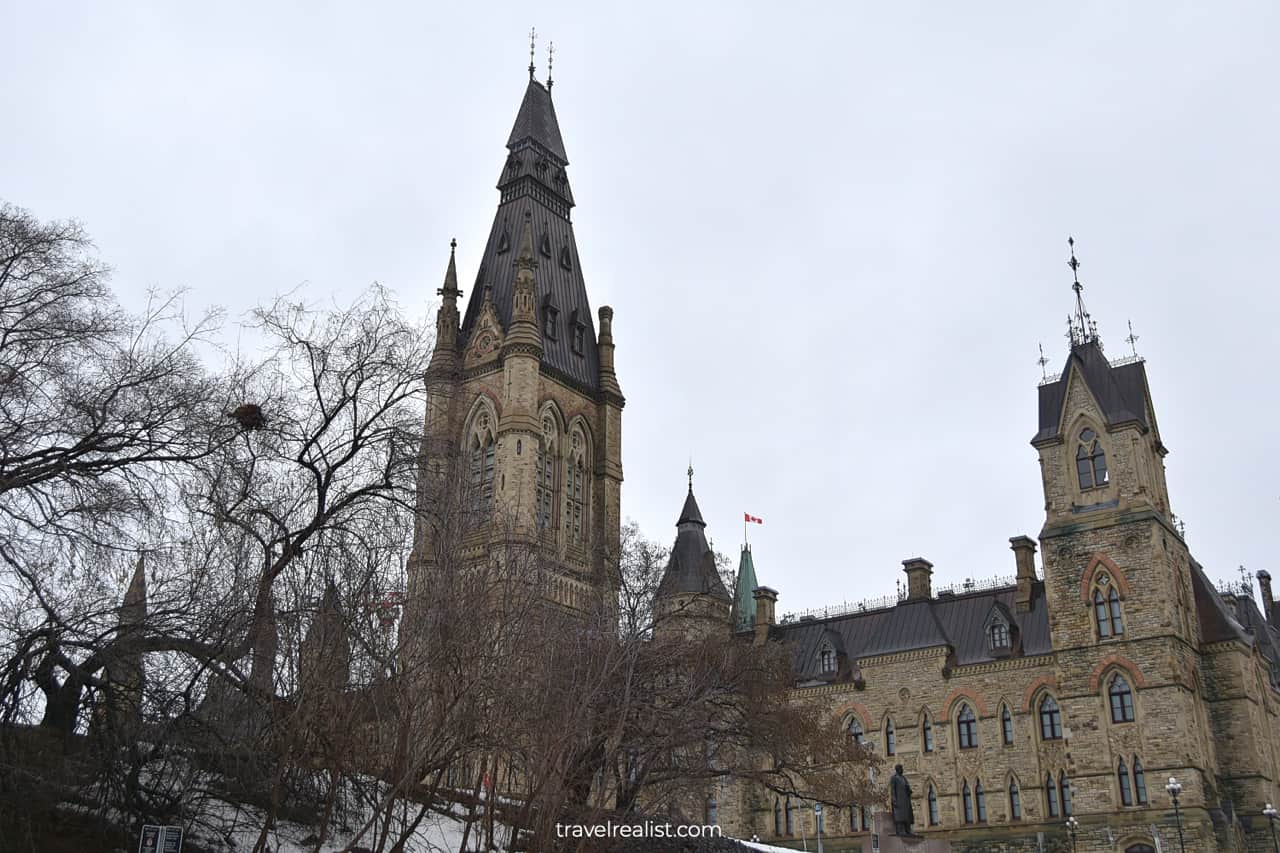
Where to Stay in Ottawa
You do not need to worry about getting a place to stay in Ottawa. The capital of Canada has plenty of hotels for every traveler. It is still a good idea to book in advance to get the best deal.
Your budget, chain, and location preferences are the main boundaries of your search. You could spend a fortune and see Parliament Hill from your window. Or you could stay further away and save a little.
Fairmont Chateau Laurier Gold Experience is the most luxurious option. You could stay right on Parliament Hill in a historic hotel. But this stay carries a location premium.
The same is true for Le Germain Hotel Ottawa, The Metcalfe by Gray Collection, and reStays Ottawa. All are great options within a short walk to the main sights. But you need to pay extra for the convenience.
There are a few budget friendly options for staying in Ottawa. Take a look at Sonder Arlo, Sonder Rideau, The Business Inn, and ByWard Blue Inn. These places to stay are a longer walk from the sights in the city.
You could always choose a chain hotel for your trip to the capital city. Check out Hilton Garden Inn Ottawa Downtown and Holiday Inn Express & Suites – Ottawa Downtown East, an IHG Hotel.
Some places to stay in Ottawa offer parking. Yet, most hotels near Parliament Hill charge extra if you park your car. You would need to book a place to stay outside of the city center to have free parking.
Do not overlook Hampton by Hilton Ottawa. This hotel is over by Via Rail station. But you could get a great experience (and free parking) at a reasonable price. These savings will pay for the O-Train ride.
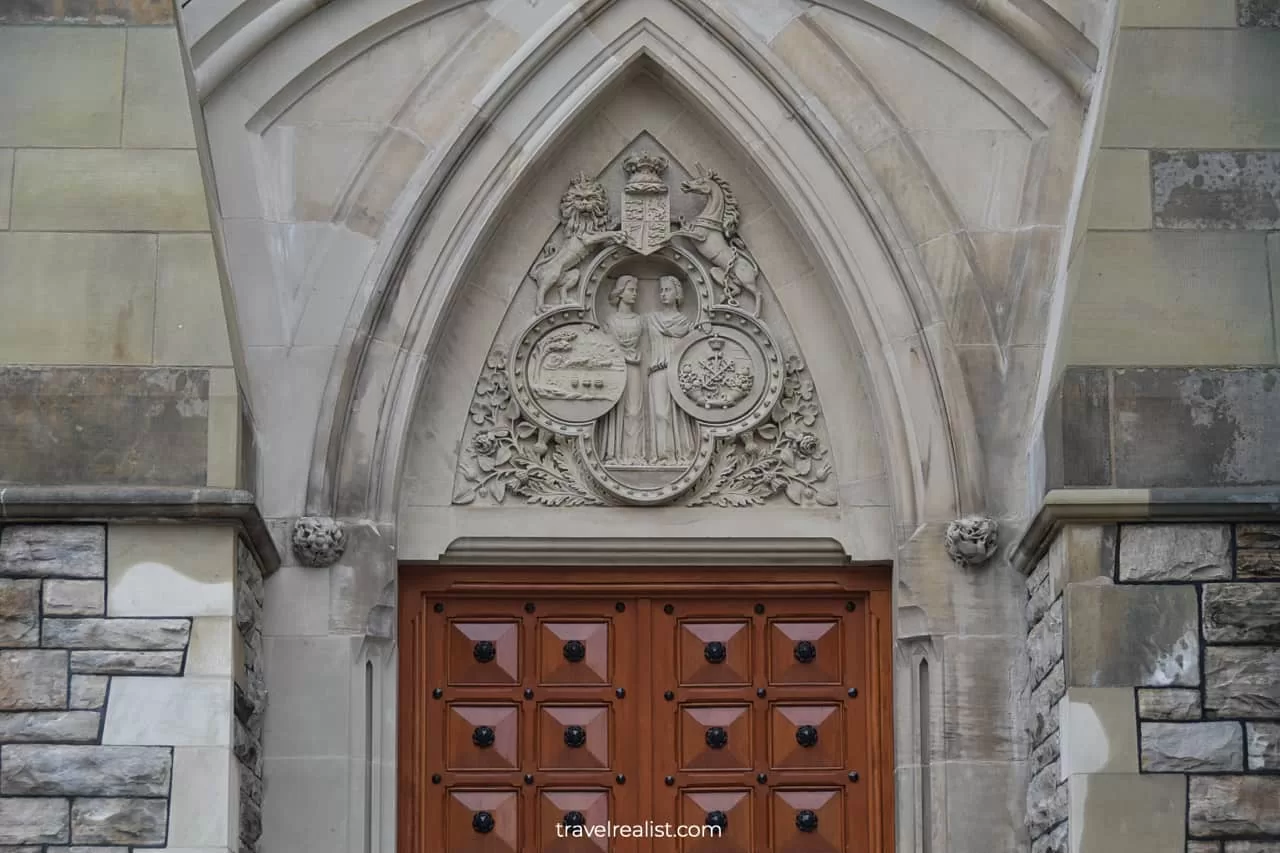
Entrance Requirements & Passes
Most sights in Parliament Hill and ByWard Market in Ottawa are part of the Canadian Government. Nevertheless, they have different opening hours and entry requirements.
You could enjoy a few buildings only from the outside. They include the Confederation Building, Justice Building, Bank of Canada, Indigenous Peoples Building, Office of Prime Minister, and Connaught Building.
Other sights are only open to guided tours or during parts of the year. This Ottawa Self Guided Walking Tour Guide documents entrance requirements and fees in one place.
- Center Block: closed for renovation. You could visit the free Immersive Experience exhibit.
- West Block: open to 40-minute guided tours throughout the year.
- East Block: open to 50-minute guided tours from June to September.
- Supreme Court: open to 30-minute guided tours on weekdays from September to April.
- St. Andrew’s Church: open 9 a.m. to 12:30 p.m. (weekdays) & 10:30 a.m. to 1 p.m. (Sundays). Free.
- Bank of Canada Museum: open 10 a.m. to 5 p.m. Thursday to Monday. Free.
- Rideau Canal Skateway: open in winter depending on weather. Free if you bring your own skates.
- Fairmont Château Laurier: book a stay to see the interior of this historic 4-star hotel.
- Senate of Canada: open to 30-minute guided tours throughout the year.
- Notre-Dame Cathedral Basilica: open 9 a.m. to 6 p.m daily. Free or $10 CAD for a guided tour.
- National Gallery of Canada: open 10 a.m. to 5 p.m. Tuesday to Sunday. $20 CAD per adult.
- Laurier House: open from May to September. Admission is $4.5 CAD per adult.
You should book the guided tours of Parliament Hill in advance. Arrive well before your tour starts to leave ample time to clear security.
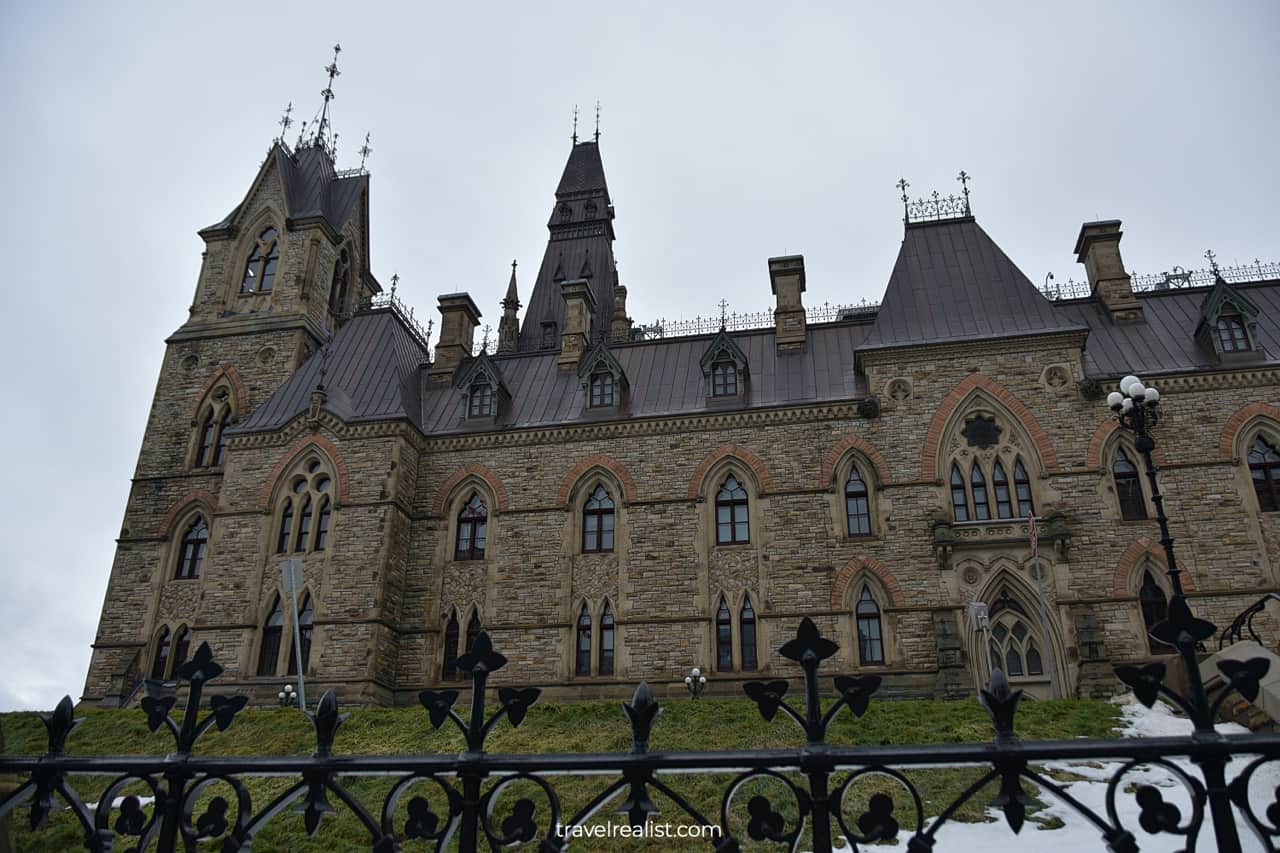
Takeaways: Ottawa Self Guided Walking Tour
Ottawa is a must-visit destination for all travelers to Canada. Parliament Hill, ByWard Market, and Gatineau have a great number of historic sights.
A canal, hotel, former railway station, churches, and government offices await visitors to Ottawa. Few cities around the world could rival the variety and beauty of these sights.
You will enjoy a self guided walk through Ottawa if you like history and architecture. You could see different styles as you go from building to building.
There is not a single season when you could tour all of the sights in the city. Most government buildings are open for tours in the summer. But the Rideau Canal Skateway works only in the winter.
If you are fine skipping the skateway, you should visit the capital early September. This way, you could see the most that Ottawa offers.
Both the East Block and Laurier House should be still open for tours. The Supreme Court might start their guided tours, too. If you are in luck, you would be able to tour the West Block and Senate of Canada.
All other sights are open year round. They do not require advance planning. You could just walk in and enjoy their beauty. You might even catch a glimpse of fall colors while visting Ottawa in September.
Budget 60 to 90 minutes to reach all sights on the self guided walking tour of Ottawa. Add more time if you tour any attractions. Therefore, it is a safe bet to budget about 3 to 5 hours to explore the city.
Take a look at this Ottawa Self Guided Walking Tour Video Guide. And visit the YouTube channel for the latest videos.
Frequently Asked Questions
The capital of Canada has a few must-visit sights. Most of them are in ByWard Market – Parliament Hill district.
– Walk around the Centennial Flame at Parliament Hill Square.
– Explore the immersive exhibit while the Central Block is on restoration.
– Take a guided tour of the East Block, West Block, Supreme Court, and Senate of Canada.
– Learn about currency and bank functions at the free Bank of Canada Museum.
– Stay at 100+ year old Fairmont Château Laurier hotel.
– See or skate on a section of the 125-mi long Rideau Canal.
– Study different architectural styles as you walk through the city center.
– Visit the Notre-Dame Cathedral Basilica.
– Enjoy art exhibitions at the National Gallery of Canada.
– Tour the house of two Prime Ministers.
Downtown Ottawa is a perfect place for a self guided walking tour. You would need to walk uphill to reach the buildings on Parliament Hill.
But other sights do not involve a steep climb. You could enjoy the sights of the city while taking a leisurely stroll.
Early September is by far the best time to visit Ottawa. You need to time your visit right. In this case, you could tour the East Block, West Block, Supreme Court, Senate of Canada, and Laurier House.
The National Gallery of Canada, Notre-Dame Cathedral Basilica, and Bank of Canada Museum are open year round.
You will see other buildings like Office of Prime Minister and Confederation Building from the outside. September is also the start of the fall foliage season in Quebec and Ontario.
Parliament Hill is the most famous attraction in Ottawa. You should not miss the Parliament of Canada.
Safe realist travels!


